



40+ RECIPES & EXPERT COOKING TIPS














40+ RECIPES & EXPERT COOKING TIPS









In my family, redfish court bouillon is a thick, tomato-based fish stew served over rice. But if you order redfish court bouillon at a restaurant in New Orleans, you might get a baked whole fish with a soupier tomato sauce instead.
version of Gulf Coast court version is a seasoned broth and, honestly, it has more Like gumbo, court bouillon ingredients vary from Gulf shrimp makes a great court bouillon, too. In the
When I’m cooking rabbit, turtle, frog legs or even alligator, I turn to a fiery sauce piquant — a much spicier, thicker tomato-based stew. Traditionally, it’s built around game, though I’ve had it with chicken as well. The name says it all: “Piquant” is French for tangy or spicy, and it really lives up to that reputation.
The only dishes you won’t find me adding tomatoes to are jambalaya and gumbo. Some things, after all, are sacred.
See page 54 for Donny Rouse’s Gumbo recipe and get the recipe for his Court Bouillion at www.rouses.com.
Creative Director & Editor
Marcy Nathan
Art Director & Design
Eliza Schulze
Illustrator
Kacie Galtier
Marketing Coordinator
Harley Breaux
Copy Editor
Patti Stallard
Advertising & Marketing
Tim Acosta
Amanda Kennedy
Stephanie Hopkins
Nancy Besson
Taryn Clement
Emily Lajaunie


David W. Brown is a freelance writer whose work appears in The Atlantic, The New York Times, Scientific American and The New Yorker. His most recent book, The Mission: A True Story, a rollicking adventure about a motley band of explorers on a quest to find oceans on Europa, is in bookstores now. Brown lives in New Orleans.
Beth D’Addono is a writer specializing in travel, food, lifestyle, and captivating stories about interesting people. She regularly contributes to outlets such as USAToday/10Best, AAA Traveler, AAA World, L.A. Times, Eater, and more. Her latest book, New Orleans Eats, is out now.
Susan Langenhennig Granger is editor of Preservation in Print magazine and director of communications and marketing for the Preservation Resource Center in New Orleans. Prior to that she was a news editor, reporter and feature columnist for The Times-Picayune and NOLA.com.
Ann Maloney was the recipes editor and a food reporter at The Washington Post, specializing in quick and easy home cooking. From 2016 to 2019, she was a food and dining writer at NOLA.com/The Times-Picayune in her hometown of New Orleans, where she also served as arts and entertainment editor from 2004 to 2015. Prior to that, she worked for The New York Times in various roles, spending most of her time as features editor for the New York Times Regional Newspaper Group.
Poppy Tooker is a native New Orleanian who has dedicated her life to celebrating the vibrant colors and flavors of Louisiana. Her NPR-affiliated radio show and podcast, Louisiana Eats!, shares her passion for food across the state and beyond. Rouses Markets is a proud sponsor of her show.



ARROW-CIRCLE-RIGHT These Gulf Coast restaurants have become local favorites and are must-tries on your travels. Look for our recommendations throughout this magazine. MAKE

ARROW-CIRCLE-RIGHT “Let’s go, baby!” Gerald Gruenig grew up over the Po-Boy Bakery, the sandwich shop on Franklin Avenue and a Gentilly staple from the 1960s, where his father, Gary “Koz” Gruenig, worked from the age of 12 until it closed after Katrina. Now a local news personality, content creator and social media star, Gerald lives in Lafayette with his wife, Ariel, and two daughters. He works on KLFY News 10’s longrunning morning show Passé Partout and hosts Acadiana Eats, having visited over 300 local restaurants, mostly mom-and-pops, and building a loyal fan base. “What kind of French bread y’all use?” He is a regular at our Rouses Markets in Acadiana. A former team captain and four-year starter at center on the offensive line for Nicholls State, Gerald is also a devoted Catholic, family man and cancer survivor. He leads his band, Gerald Gruenig & Gentilly Zydeco, playing at festivals across the state. “Alright, lemme get it!”








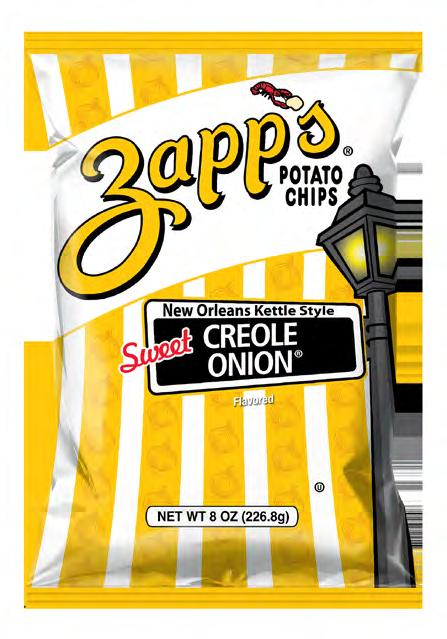





by Marcy Nathan
I published my first recipe, tucked inside the pages of I Cooked It!, the Isidore Newman School cookbook, when I was seven. I was one of the youngest contributors and a certified nepo baby — my mom was on the cookbook committee, and one of her best friends ran the whole thing.
I wish I could tell you what my recipe was. I recently stumbled upon an old copy at a used bookstore, but unlike the Junior League Cookbook, names aren’t listed beside the recipes. I can only hope mine was a notch above “Boiled Eggs,” “Purple Cow” or “Jell-O Surprise.” And surely it wasn’t as questionable as “Jelly Omelet” or “Mardi Gras Soup,” which featured two hot dogs, a can of beans with bacon and a can of water. Bon appétit!
I have to believe I actually came up with my own recipe — unlike, say, whichever Zoller child submitted the so-called “Zoller Lemon Squares.” It calls for grated lemon rind from
one lemon and describes them as “refreshing.” I’m pretty sure we all know that recipe belongs to their mom, Linda. Her son, Glenn, was my BFF, and I don’t remember him or his brothers or sister ever making anything so fancy.
Most of our magazines start with an editorial theme, and what stories we want to tell. Then it’s all about finding recipes that fit those stories. That’s how we decide what we want to cook — and then, it’s about who we want to cook it. You’ll never find a better Cajun cook than Marcelle Bienvenu, or a better New Orleans bordelaise than Frank Brigtsen’s.
But this issue was different — it started with the recipes. We’re bringing back some of our most popular magazine and most clicked recipes, including Donny Rouse’s Seafood Gumbo with Sausage, which was first featured in our 2022 Gumbo Issue and is now the most popular recipe on our website.
We’re also sharing recipes inspired by some of our signature bakery items — while we can’t give away all our secrets, these recipes come mighty close.
If you’re looking for new inspiration, you’ll find fresh ideas from
recently released cookbooks, like Modern Creole by Eric Cook, the chef and restaurateur we profiled in that same Gumbo Issue in 2022.
And hey, if you’re looking for the recipe for Jelly Omelet, feel free to borrow my copy of I Cooked It!
ZOLLER LEMON SQUARES I Cooked It!
WHAT YOU WILL NEED:
1 cup flour
¼ cup powdered sugar
Pinch of salt
1 stick butter or margarine
2 eggs, slightly beaten
1 cup granulated sugar
2½ to 3 tablespoons fresh lemon juice
Grated lemon rind from 1 lemon
HOW TO PREP:
Preheat oven to 350˚F.
Mix flour, powdered sugar and salt in a mixing bowl. Blend butter into the mix with a fork or your fingers. Press mixture evenly into the bottom of an 8” x 8” buttered baking pan. Place in the preheated oven and bake for 20 minutes. While crust is baking, mix together all other ingredients. As soon as crust has baked, pour mixture over crust and return to oven for 20 to 25 minutes.
Remove from oven and let cool. Cut into squares and sprinkle with sugar! These cookies are delicious and refreshing!




by Tim Acosta, Rouses Markets Advertising & Marketing Director
Here on the Gulf Coast, most of us are born with a wooden spoon — or a cast-iron skillet — in our hands. Food isn’t just something we make, it’s part of who we are. We learn how to cook from our parents, who learned from theirs. Techniques — and Magnalite pots — get passed down through the generations. My sister got my grandmother’s big pot. My wife and I got a whole set as a wedding present, more than 40 years ago.
So, for traditional Cajun dishes like jambalaya and white beans and gumbo, I don’t need a recipe. I’ve made them so many times, I just know — a pinch of this, a pour of that, a sprinkle of green onions and parsley, and always a dash of Cajun Power Garlic Sauce.
As for that all-important “How long will this take?” question — I like to measure that by how many beers it takes.
But when it comes to re-creating a dish I saw online or on a TV show, or one my wife and I tried while traveling — like the paella we had on our first trip to Barcelona (I didn’t even know what paella was at the time) — and we’re curious about how it was made (similar
to jambalaya), I always start with a recipe to get the foundation right. It also helps to have the right cookware, so of course I went out and got a paella pan to go along with my jambalaya pot. You can never have too many pots and pans.
And if you want consistency in the kitchen, recipes are your best friend. Cooking is all about ratios, techniques and timing. Some things never change. Take rice: It’s always a 2:1 water-to-rice ratio, and no matter how impatient you get, rice takes the time it needs.
In this issue, we’ve pulled together some of our most popular recipes for those times when you want step-by-step guidance, like my cabbage casserole (see page 56 ) and smothered potatoes with green onion sausage. And we have a lot more online; we even have cooking and boiling guides on our website.
So, save this issue and bookmark our website (www.rouses.com).
That way, the next time someone asks you, “Whatcha cookin’?” you’ll have plenty of inspiration.
TOTAL TIME: 40-45 minutes
SERVES: 6
STORAGE: For refrigerated leftovers, reheat in a skillet over medium heat, adding a little water or broth if needed to keep potatoes moist.
5 pounds Yukon Gold potatoes, cut into chunks
1 pound Rouses Green Onion Smoked Sausage, sliced
1 stick (8 tablespoons) unsalted butter
1 large yellow onion, diced
1 bunch green onions, chopped
4 cloves fresh garlic, minced Rouses Creole Seasoning, to taste
1 cup unsalted chicken or vegetable stock (or enough to cover potatoes)
Salt and pepper, to taste
In a large cast-iron skillet over medium heat, brown the smoked sausage slices. Once browned, remove the sausage from the skillet and set aside. In the same skillet, melt the butter. Add the diced yellow onions, chopped green onions and minced garlic. Sauté for about 5 minutes, or until the onions are softened and fragrant. Add the potato chunks to the skillet. Season with Creole seasoning, and pour in enough stock to just cover the bottom of the skillet (around 1 cup). Stir well to incorporate everything. Reduce the heat to low, cover the skillet with a lid, and cook for about 15 minutes to allow the potatoes to soften. Return the browned sausage to the skillet and continue cooking, uncovered, for another 20-25 minutes, stirring occasionally, until the potatoes are fork-tender and the liquid has reduced. Add salt and pepper to taste. Stir everything well to ensure the flavors are evenly distributed. Serve hot.

ARROW-CIRCLE-RIGHT In the wake of Hurricane Francine, we partnered with Second Harvest Food Bank to support 1,200 families in Houma and Thibodaux through our “Fill the Fridge” events. We are committed to providing our community the resources they need during such challenging times. #localshelpinglocals


That means it’s time for Canned Good. Loads of infinitely recyclable steel food cans are being packed with harvested deliciousness, for variety, year-round. From harvest to can to your next meal — steel food cans help avoid food waste and feed families.

SPONSORED BY








by Ali Rouse Royster, 3rd Generation
When I was a tween, my dad brought me to his office to work, often leaving me in the very capable hands of Celeste — who probably didn’t sign on for babysitting along with her accounting duties! I worked on projects for both of them — small tasks at first, but they grew bit by bit over the years.
I remember sitting on the floor in front of Celeste’s desk, sorting things by store (we had seven at the time, so I just made a stack for each one). I filed, used a calculator with a tape to balance entries,
and gradually learned all the small but essential tasks that keep Rouses running.
When I made mistakes, Celeste always made sure I understood why and how we were going to fix them together. Her grace and wisdom were exactly what I needed as I found my way through what eventually became our accounting, finance and IT departments — back then, that was just a few people crowded around a few desks in a way-too-small office! And to this day, Celeste is my sounding board whenever I’m unsure whether something will work in our system.
I’m not sure what Rouses will look like without her, and I’m not particularly eager to find out! But Celeste deserves to enjoy her well-earned retirement with her husband Aaron, her lovely daughters Cierra and Lesley, and her beloved grandchildren. On behalf of my family and our entire team, I wish her the very best, now and in all the years to come. Rouses is a better place because Celeste helped shape it, and her legacy here will be cherished.








Working in a professional kitchen teaches you tricks you won’t always find in cookbooks. We’ve rounded up some of our deli managers’, chefs’ and cooks’ favorite tips to make you a better home cook.
ARROW-CIRCLE-RIGHT This may sound obvious, but it’s one of the most important things you can do: Plan ahead. Always read the recipe thoroughly before starting, and gather your ingredients, pans, utensils and tools (this is your mise en place, which is French for “everything in place”) before you start cooking. This includes chopping, peeling and prepping everything beforehand — you don’t want to be halfway through making your sauce only to discover you need garlic, but you’re out of garlic!
ARROW-CIRCLE-RIGHT To tackle any kitchen task, you only need three essential knives: an 8-inch chef’s knife, a bread knife and a paring knife. The chef’s knife is the most versatile tool in your kitchen, perfect for cutting, chopping, slicing, dicing and mincing vegetables, fruits and herbs. It can even handle tasks like taking apart a whole chicken or disjointing large cuts of meat. For better control, grip the knife at the bolster with your thumb and forefinger on the blade. The bread knife is ideal for slicing bread, bagels and more; it’s also perfect for leveling cakes or cutting delicate slices. The paring knife is for precise cuts and even doubles as a potato peeler. Keep your knives sharp — dull blades increase the risk of accidents. And don’t forget to secure your cutting board: Place a damp paper towel underneath to prevent slips and make your prep safer.
CHOP MORE EFFICIENTLY:
ARROW-CIRCLE-RIGHT When chopping herbs, sprinkle a little salt on your cutting board

to keep them from scattering. This simple trick helps you chop more efficiently and keeps your workspace tidy.
TOAST YOUR SPICES:
ARROW-CIRCLE-RIGHT Want to add depth to your dishes? Toast your spices. Heat them in a dry skillet for a few minutes to release their essential oils, unlocking their full flavor and aroma. Whole spices take 3-5 minutes, while ground spices need just about a minute. This simple step can elevate the taste of any dish.
BLANCH YOUR VEGGIES:
ARROW-CIRCLE-RIGHT For quick-cooking methods like sautéing, blanch vegetables first to preserve their vibrant color and crisp texture. Simply boil them briefly, then plunge them into ice water to stop the cooking process. This technique is key before freezing veggies like broccoli, leafy greens, string beans, okra, asparagus, sweet potatoes, pumpkin, spaghetti squash and tomatoes. Blanching ensures the vegetables look and taste better when you cook them later. No need to blanch onions or peppers — they’re good to go as is!
KNOW YOUR VEGGIES:
ARROW-CIRCLE-RIGHT For carrots and other vegetables high in sugar and starch, the key is to maximize surface area when cutting. This helps their natural sugars caramelize as they cook, resulting in a sweeter flavor and faster cooking time.
ARROW-CIRCLE-RIGHT When heating oil, some cooks prefer adding it to an already hot pan, while others heat both the pan and oil together. Either way, make sure the oil is hot before adding food. If it’s not hot enough, your food will soak up the oil instead of sizzling in it. To test, swirl the oil — if it moves quickly and shimmers with visible “fingers,” it’s ready. You can also dip the handle of a wooden spoon into the oil; if bubbles appear, it’s hot enough. If the oil starts smoking, don’t panic. Remove it from the heat, pour it into a heat-proof container, lower the heat, and start over.
ARROW-CIRCLE-RIGHT Roasting vegetables and fruits at high temperatures brings out their best. Brussels sprouts, carrots, beets, broccoli, cauliflower, sweet potatoes, and even peaches and lemons develop tender insides, crispy exteriors and concentrated flavors with a touch of smokiness when roasted at 425°F. For the best results, roast starchy and hardy root vegetables separately from highmoisture vegetables to ensure even cooking and perfect texture for each.
DON’T OVERCROWD:
ARROW-CIRCLE-RIGHT Whether you’re roasting or sautéing, give your ingredients room
to breathe. This lets air — or hot oil — reach all the foods’ surfaces. Overcrowding the pan traps moisture and prevents proper caramelization, or browning. For the best results, cook in batches if necessary.
ARROW-CIRCLE-RIGHT You probably already know about saving some of the pasta water from your spaghetti to make sauces. Rich in starch, pasta water thickens sauces and helps them stick to the noodles. Rice water is also packed with starch and nutrients. Use it as a base for soups or broths, or steam vegetables with it to add extra flavor. And the water from boiled veggies? Reduce it to make a flavorful stock, or use it as a soup base for an extra layer of taste. Waste less, flavor more.
ARROW-CIRCLE-RIGHT For the best of both worlds in cooking, mix oil and butter in a 1:1 ratio. The oil raises the smoke point, preventing the butter from burning, while the butter adds rich flavor. This simple combo works wonders for sautéing veggies, frying eggs and more — giving you perfect texture and taste every time.
ARROW-CIRCLE-RIGHT Finish your pan sauces like a pro with monter au beurre — which means “to mount with butter.” Add cold butter cubes to your hot sauce and swirl until melted. This technique creates a velvety texture and a glossy finish, and helps balance sharp flavors like vinegar or garlic.
SEASON FROM A HEIGHT:
ARROW-CIRCLE-RIGHT Ever see a chef dramatically sprinkle salt from high above the dish? It’s not just for show. When you season from a height, the salt (or spice) is distributed more evenly, ensuring every bite is perfectly seasoned.
ROTATE YOUR PANS:
ARROW-CIRCLE-RIGHT Since ovens don’t always cook evenly, rotating your pans halfway through baking ensures everything cooks properly. If you’ve got one pan, simply rotate it 180°. If you have two pans, rotate each 180° and swap their positions — whether side by side or on different racks. These simple steps balance the heat and help everything cook perfectly.
WARM YOUR DINNER PLATES:
ARROW-CIRCLE-RIGHT Cold plates cool down hot food too quickly. For a restaurant-quality meal, warm your dinner plates in the microwave for one minute or in a 200° oven for five minutes before you serve on them, to keep the food at the perfect temperature.
These simple yet effective chef’s tricks can transform your home cooking and give you the confidence to cook like a professional. Try them out, and you’ll notice a big difference in your kitchen.


ARROW-CIRCLE-RIGHT Added too much salt? Balance it out with a sweet ingredient like honey or sugar.
ARROW-CIRCLE-RIGHT If the dish is too rich or fatty, a splash of vinegar or citrus will cut through the heaviness.
ARROW-CIRCLE-RIGHT Too spicy? Try adding lemon, lime, orange juice or a splash of vinegar — just remember, a little goes a long way. Taste as you go for the perfect adjustment.
ARROW-CIRCLE-RIGHT If your cream sauce separates, don’t panic! A few spoonfuls of warm water can help balance the fat and bring it back together.
ARROW-CIRCLE-RIGHT For broken gravy, make a roux with one tablespoon of butter and one tablespoon of flour in a fresh pan. Slowly whisk in the broken gravy, a little at a time, until it’s smooth and fully incorporated.
PAPA-ROCCO’S PIZZA & OYSTERS, GULF SHORES, AL
ARROW-CIRCLE-RIGHT Since 1985, this local gem has been serving up cold beer, hand-tossed pizza and fresh Gulf oysters — despite its playful claim of being the “home of warm beer and lousy pizza!” The laid-back vibe pairs perfectly with great bar food, including stuffed mushrooms with oysters, and nightly live music keeps the energy going.
ARROW-CIRCLE-RIGHT
“We have our own line of authentic Italian products, carefully selected and imported directly from regions in Italy where they have been made for hundreds, sometimes even thousands, of years. With strict standards for ingredients and production methods, we ensure only the highest quality — because Italians, like us, are passionate about food.”
– Donny Rouse, 3rd generation

ARROW-CIRCLE-RIGHT Well over a century after the Rouse family immigrated to America, their Italian heritage continues to be celebrated in every aisle of Rouses Markets. You can find a taste of their family’s history in everything from San Marzano tomatoes and “00” flour to Modena balsamic vinegars and Pecorino Romano cheese, sourced from Sardinia — the Rouse family’s original home.
by

By David W. Brown
When New Orleans Chef Frank Brigtsen recalls the neighborhood restaurants of his childhood — places like Liuzza’s on Bienville Street (which is still open) and Restaurant Mandich on St. Claude Avenue (which is not) — he can still see the neon signs they all had out front, with words like “Steak,” “Seafood” and “Italian” glowing in bright green and pink letters.
Amenu might have a full page of seafood, a full page of Italian dishes and a few steaks tucked somewhere in the corner. The Italian section always had spaghetti and meatballs, veal or eggplant parmesan and, especially, spaghetti bordelaise.
“To me, that was a New Orleans restaurant,” Brigtsen says. And his celebrated restaurant, Brigtsen’s, located in the Riverbend neighborhood of Uptown, still has eggplant parmesan with spaghetti bordelaise on its menu.
But “bordelaise” means something completely different in New Orleans than it does anywhere else in the world.
“At the turn of the 20th century, Sicilians came over and changed New Orleans food forever, in the most wonderful way,” says Mary Ann Fitzmorris, who runs The New Orleans Menu, the culinary newsletter and website founded by her husband, Tom Fitzmorris, in 1977.

“What we call bordelaise in New Orleans is really a reworking of ‘aglio e olio,’ which is Italian for garlic and olive oil. Somehow, ‘bordelaise’ became one of those bastardized words, which happens a lot in the food world.”
Everywhere else, bordelaise is a classic French brown sauce made from red wine and named for its region of origin, Bordeaux. “Like meunière sauce and like rémoulade, in our unique New Orleans style, we do it nothing like the French,” says Chef Brigtsen.
“Our bordelaise, on the other hand, is garlic and olive oil (or sometimes butter), as well as parsley and spaghetti. And I love it because it’s so simple. It’s just plain delicious.”
Chef Brigtsen’s recipe for bordelaise is a slight variation on this theme. “You’ll see this in a lot of my sauces. It’s not just olive oil or just butter,” he explains, as that would make the sauce a bit too oily. His bordelaise involves what’s called an emulsified butter sauce, which yields a creamy dish.
“For my spaghetti bordelaise, when I cook the pasta, when it’s almost done, I scoop out maybe a cup or more, depending on what I need, of the pasta cooking water. By that time, it’s starchy, a little cloudy — and I use it like a stock.”
Separately, on the stove, he begins with olive oil, then adds parsley and garlic. He very quickly sautés it so the garlic doesn’t burn. “Then we add that pasta water, bring it to a boil, and finish it with butter.” The next step: “Shake it, shake it, shake it, until it’s nice and creamy.” Add a little salt, and then add the pasta, says Brigtsen.
Instead of being an oily sauce, it sits lighter on the palate. “That’s a technique that I’ve been doing forever,” he says. “It’s a little more elegant and a little more powerful. You know, whenever you eat something that’s garlicky, it automatically tastes better.”
He learned the technique from the master, Chef Paul Prudhomme. Chef Brigtsen began his culinary journey in 1973. Six years later, he found an apprenticeship at Commander’s Palace under the guidance of Prudhomme. When Prudhomme later opened K-Paul’s Louisiana Kitchen for dinner service, Brigtsen became its first night chef.
The two worked together for the next seven years, with Brigtsen eventually being made the restaurant’s executive chef. In 1986, Prudhomme and his wife, Kay, helped Brigtsen and his wife, Marna, open Brigtsen’s. They’ve been feeding New Orleans ever since.
Most of the time, he says, spaghetti bordelaise is a side dish for the main course — typically a veal dish or chicken parmesan. “But it’s a very expandable concept. You could add a variety of seafoods to that: shrimp, crabmeat, oyster — anything like that — and it’s going to be delicious.”
Brigtsen says that when he gets a craving to bring something home from work to eat later, frequently, he decides on an oyster pasta bordelaise. “It’s the same recipe, but I add a half-dozen oysters. They cook so quickly, and the oyster water bleeds out into the sauce. It’s fabulous. Maybe put a little crushed red pepper flakes on top, a little parmesan, and you’ve got a great meal, quick and simple — it’s the garlic that carries the whole thing.”
It is a staple of Creole cuisine, he says, adding that “Creole” means a lot more than simply a handful of old recipes. Rather, it is the confluence of several different cultural influences, most prominently French, African and Italian. “The beauty of Creole cuisine is that it’s multicultural,” he says. And it continues to evolve.
“What we endeavor to do at Brigtsen’s is respect the story of Creole,” he says. “Every day, when I put on my white jacket, I’m representing 200 years of real culinary history, and what you’ll find on the menu are the classics — trout meunière or eggplant parmesan with spaghetti bordelaise.”
He notes that tastes in New Orleans are changing, and that authentic Creole is not necessarily the most sought-after cuisine these days. Some guests, he says, only order the more “adventurous dishes” on the Brigtsen’s menu. “I’m not cooking for me — I’m cooking for them.” He adds: “This is the new New Orleans, you know. So I just try and give it my all.”
The shift in New Orleans cuisine away from classical Creole is a post-Katrina development, Fitzmorris says.
“Young people from all over the country came down here to rebuild the city,” she explains. “They didn’t have a culinary history of their own because the food of Peoria, for example, has never been known the way New Orleans’ food has.”
Many of those young people are still here — and aren’t all that young anymore. “Their tastes have changed the dynamics of a New Orleans food culture that has been celebrated for centuries,” she says. “There’s an evolution to everything, but I think there will always be a taste for the classics.”
Which means New Orleans bordelaise isn’t going anywhere.
Chef Brigtsen agrees. “I really try and represent traditional Creole cuisine,” he says, “because as time goes on, if somebody asked you where to go get classic Creole food, how many answers would you have? It’s a smaller and smaller number. And I’m very proud to still represent that.”
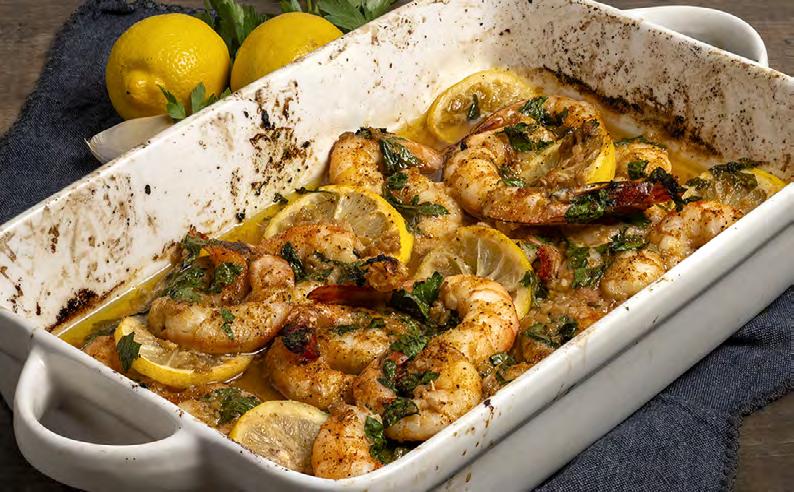
Makes 5-6 portions as a side dish
Chef’s Notes: Pasta Bordelaise is commonly made with olive oil and/or butter, garlic and parsley. In this recipe, we use the cooking water from the pasta as a “stock” to create a lighter, more palatable sauce that is not so oily. Timing is key here, so you should coordinate the cooking time for the pasta with the skillet sauce.
3 quarts water (to cook pasta)
1 pound dried spaghetti
3 tablespoons olive oil
1 tablespoon minced fresh garlic
3 tablespoons finely chopped parsley
¼ teaspoon salt
¼ cup reserved pasta water
4 tablespoons unsalted butter, softened
12 tablespoons finely grated Parmesan cheese
HOW TO PREP:
Bring the water to a boil and add the spaghetti. Cook until tender but firm (al dente), about 10 minutes.
When the spaghetti is almost done, reserve ¼ cup of the pasta water, then heat a large skillet over medium heat. Add the olive oil to the skillet. Quickly add the garlic, parsley and salt, shaking the skillet constantly. Sauté for 5-10 seconds, being careful not to brown the garlic.
Add the reserved pasta cooking water, and bring to a boil.
Add the butter and reduce heat to low. Shake the skillet just until the butter melts into the sauce.
Quickly drain the cooked pasta and add it to the skillet. Toss to coat the pasta with the sauce. Place the pasta on serving plates and top each portion with about 2 tablespoons finely grated Parmesan cheese.
NEW ORLEANS SHRIMP BORDELAISE
TOTAL TIME: 35 minutes SERVES: 6
WHAT YOU WILL NEED:
2½ to 3 pounds large shrimp (16-to-20count), in the shell
½ cup olive oil
3 tablespoon minced fresh garlic
4 tablespoons finely chopped parsley
½ teaspoon salt
10 tablespoons unsalted butter, softened
3 tablespoons fresh lemon juice
¾ cup finely grated Parmesan cheese
8 thin, half-moon lemon slices Lemon wedges, for serving
HOW TO PREP:
Position a rack in the middle of the oven and preheat to 425°F.
Peel, devein and butterfly the shrimp, leaving the tails intact if desired.
In a large skillet over medium heat, heat the olive oil until shimmering. Immediately add the garlic, parsley, and salt. Shake the skillet constantly and sauté for just a few seconds to prevent the garlic from burning. Reduce the heat to low, stir in the butter and lemon juice, and cook just until the butter is melted.
Starting from the outer edge of a 14-inch oval gratin dish, arrange the shrimp

ARROW-CIRCLE-RIGHT “Around 1899, my great-grandfather came over from Sardinia. He came in through New York with a sponsor, and he had to get work. He had to be settled in before he could send for his wife — my great-grandmother — and my grandfather. He moved to Westwego, adjacent to New Orleans, where there was a thriving Italian community. There, he found a job on a little farm, and worked tirelessly until he could afford to set up a sharecropper deal with the landowners. My great-grandmother, and their two children, came over in 1900. My grandfather, Joseph “J.P.” Rouse, founded City Produce in 1923. My father, Anthony J. Rouse, opened our family’s first grocery store in 1960.”
– Donald Rouse, 2nd generation

in a single layer, cut side down, with the tails curling towards the center. Pour the garlic butter mixture evenly over the shrimp. Sprinkle with Parmesan cheese, then tuck the lemon slices between the shrimp. Bake for 10 to 12 minutes, or until the shrimp are pink, curled, hot and bubbly. For a golden, crispy top, place the dish under the broiler for an additional minute. Watch carefully to prevent burning. Serve hot with extra lemon wedges on the side. Enjoy!
PATACON LATIN CUISINE, LAFAYETTE AND YOUNGSVILLE, LA
ARROW-CIRCLE-RIGHT The restaurant’s signature patacón sandwiches — made with fried green plantains instead of bread — are a fan favorite, filled with everything from beef to seafood. With the success of the Lafayette location, Patacon expanded with a food truck and a new restaurant in Youngsville.
ARROW-CIRCLE-RIGHT More than four million Italians immigrated to America between the 1880s and 1920s. Like many other immigrants, they held onto their rich culture, especially through their cooking. When they couldn’t find the exact ingredients they used back home, they adapted by using what was available in local markets. These Italian immigrants helped create an entirely new cuisine: Italian American. Dishes like shrimp scampi, baked ziti, chicken Parmesan, and even spaghetti and meatballs are now staples of Italian American cooking.
ARROW-CIRCLE-RIGHT In 1902, Giacomo “Jacob” Cusimano built the largest macaroni factory in the United States at the corner of Barracks and Chartres streets in New Orleans. The factory was capable of churning out 10,000 pounds of pasta a day. Cusimano’s pasta plant manager, Leon Tujague, was a founding partner in the Southern Macaroni Company, which created Luxury Brand pasta in 1914.
“Spaghetti houses” (red gravy restaurants), serving what today we call Creole Italian cuisine, rose to prominence on the restaurant scene in the French Quarter and beyond. But they were not confined to the French Quarter. Manale’s Restaurant, now known as Pascal’s Manale, opened in 1913 in a former corner grocery store at Napoleon Avenue and Dryades Street.
ARROW-CIRCLE-RIGHT Open since 1966, Gino’s is a Baton Rouge institution known for its crusty, cheesy Laurence Bread and famous arancine — fried Italian rice balls stuffed with ground meat, sauce, peas and Parmigiano cheese. When in season, you can also find crawfish and seafood variations of these must-order bites.
ARROW-CIRCLE-RIGHT In New Orleans, most Italian immigrants came from Sicily. The Port of New Orleans was a major gateway for Italian immigrants. Sicilians had been coming to New Orleans in significant numbers since the 1830s. Creole Italian refers to the unique blend of Sicilian food traditions with French Creole cuisine. A classic example of this fusion is red gravy, a roux-based tomato sauce. One of New Orleans’ longest-operating Creole Italian restaurants began its life as a grocery store. Sebastian Mandina, a Sicilian immigrant from Palermo, opened Mandina’s in Mid City as a grocery store in 1898. The family lived upstairs. Mandina’s evolved into a pool hall and sandwich shop; then in 1932 it became a restaurant, which is still serving seafood and Creole Italian food today.
by Beth D’Addono
There is one thing that Villa Harlequin managing partner Blakelee Kibodeaux knows for a fact.
“If we ever took the lasagna off the menu, there’d be a riot,” he said. The epitome of Italian comfort food, the restaurant’s Bolognese version layers fresh pasta with a meaty red sauce and creamy bechamel.
“It was a big reason why I joined the team. We were regular patrons and it was so hard for me to order anything else. I knew the rest of the menu had to be just as good. I’m so excited to be here.”
Kibodeaux joined the business in June, when Villa Restaurant founders Mike and Brenda Sperandeo retired after 50 years in the hospitality business. It was the latest in an evolving story of the uniting of two family-owned restaurants with decades of loyal customers. In 2019, the Sperandeos joined forces with Lake Charles mayor Nic Hunter and his wife Becky. Hunter’s family had founded Harlequin Steaks & Seafood in the 1950s.
“I had this crazy idea of running for mayor in 2017, and I won,” he recalled. “I saw immediately that I wouldn’t be able to give the restaurant the time it deserved. Mike and I had talked about a partnership, so the time was right.”
The new Villa Harlequin restaurant found its home in the historic Craftsmen-era Noble Building downtown on Pujo Street, a longtime hub for oil and gas innovation. Named for C.O. Noble, the engineer who played an integral role in drilling the first oil well in Louisiana in 1901, the building was painstakingly restored by local preservationists Rick and Donna Richard.
Joining two restaurant dynasties created an experience both familiar and new for its army of regulars. The Villa’s Italian family recipes joined a menu of steak- and Louisiana seafood-forward dishes. These included Hunter family secret recipes for the likes of Mrs. Hunter’s thousand island dressing and a signature Creole tomato soup studded with jumbo lump crabmeat.
The light-filled restaurant is both modern and approachable. “We put the emphasis on a fresh, quality product,” said Kibodeaux. “Our guests can come in casually dressed and feel comfortable.”
On the first floor, a large, square bar seats 10, with another 78 guests accommodated at tables around the bar and upstairs with mezzanine seating. Architectural and design details include a soaring cathedral ceiling, banks of original windows, wooden accents and a marble bar. There are tables tucked away into intimate nooks that offer the ideal setting for private conversation. A former engineer’s office is now a small private dining room.
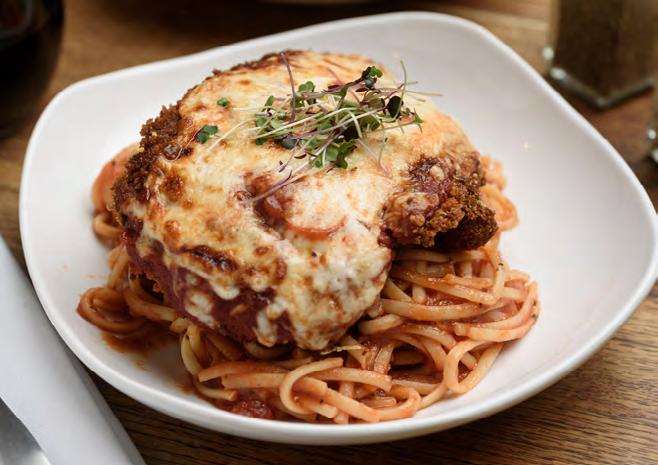
THE BEST OF BOTH WORLDS Kibodeaux, 38, brings 15 years of restaurant experience to the table, most recently at The James 710 and Vic & Anthony’s Steakhouse. The Crowley native has spent the past nine years digging into hospitality in Lake Charles. He and his wife knew Nic and Becky Hunter socially. “We were talking over dinner one night about restaurants, and I said I’d always been interested in the ownership aspect,” he recalled. “The timing was perfect.”
Although his ownership role involves running the restaurant day to day, there wasn’t any thought of making big changes. As a regular customer prior to joining the team, Kibodeaux was already a big fan. “There is no need to reinvent the wheel,” he said.
The kitchen team is led by chefs Colin Nunez and Paul Fisher. Together, they offer creative specials incorporating modern ingredients while still paying homage to the restaurants’ deep local roots. One example is the crab cake, served with nduja cream sauce. Another is the limoncello and blueberry cheesecake served with fresh blueberry compote and limoncello sauce. Taking a sophisticated approach to the classics is just one way the restaurant’s culinary conversation continues to evolve.
“We bring the best flavors from two local families to the table,” said the new partner. “That’s a lot of history on the plate. And we’re proud of that.”

Photos courtesy Villa Harlequin

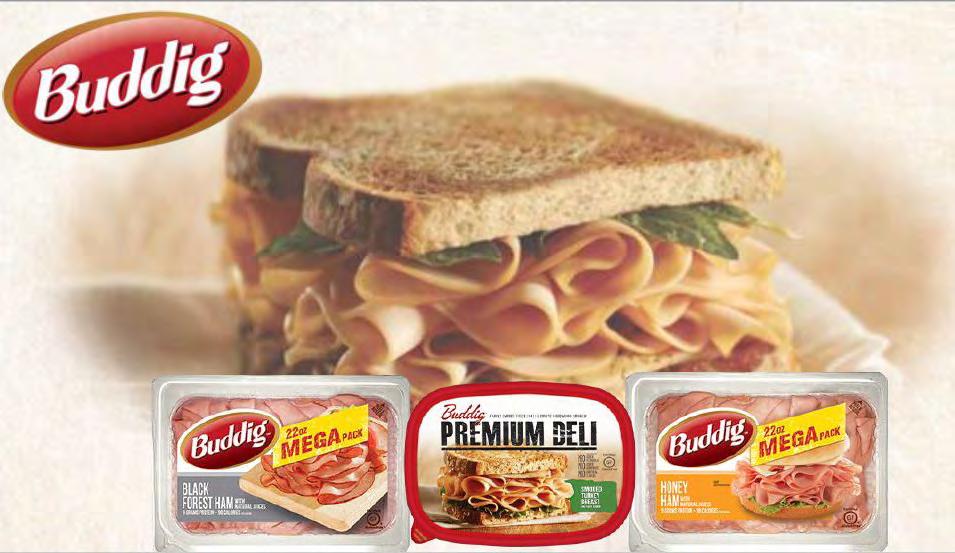
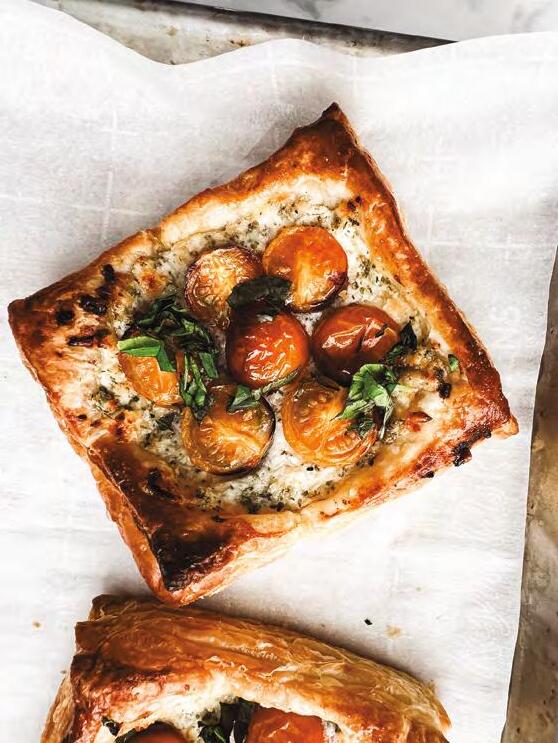




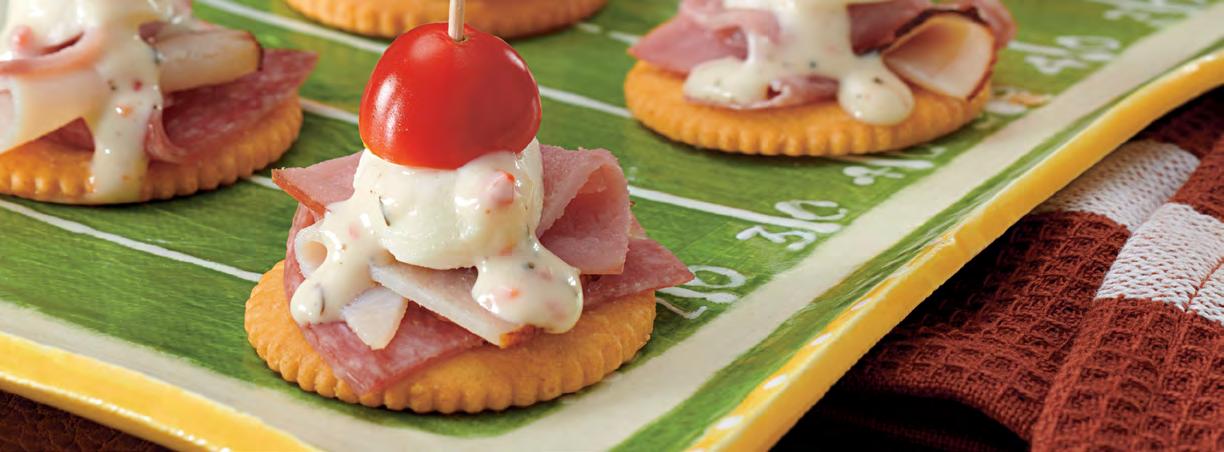







ARROW-CIRCLE-RIGHT For home cooks interested in cooking like a chef, Modern Creole opens that door. The recipes are familiar renditions of Southern comfort food, with many incorporating fresh seafood and other products familiar to the Gulf South region.
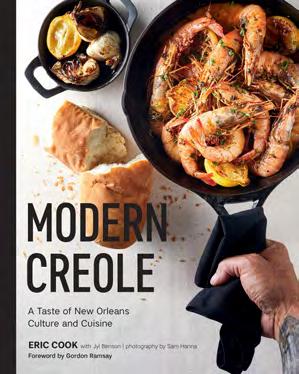
by Beth D’Addono
When he set out to write his new cookbook, Modern Creole, New Orleans native Eric Cook knew he wanted to get back to his roots. “I didn’t grow up eating blackened redfish and chargrilled oysters,” he said. “I wanted to get back to real Southern roots, to elevate the kind of home cooking so many of us grew up with.”
It’s the kind of food he loves and serves at his own restaurants in New Orleans: Gris-Gris in the Lower Garden District and Saint John, which is relocating from the French Quarter to 715 St. Charles Avenue this fall.
Cook’s passion project came together with the help of New Orleans writer Jyl Benson; it’s illustrated with Sam Hanna’s photography. The collection of 120 food and cocktail recipes connects the dots between contemporary Creole cuisine and the food memories Cook conjures from his childhood. Although he can cook plenty fancy — and did at places like Brennan’s and Commander’s Palace — Cook relishes the one-pot dishes that were a staple at his home. “There were four kids in the family,” he said. “There was always a pot of beans on the stove.”
For home cooks interested in cooking like a chef, Modern Creole opens that door. The recipes are familiar renditions of Southern comfort food, with many incorporating fresh seafood and other products familiar to the Gulf South region.
The chef mined his own childhood favorites, including his mother’s chicken and dumplings — always his choice for a birthday dinner. Cook’s Creole white bean dish, made with tasso, thick-cut bacon and smoked pork hock, is one fan favorite; his signature gumbo, with its dark glossy roux, is another.
There are swankier options too, like Creole tomatoes with shrimp remoulade and classics like crawfish étouffée and chicken Clemenceau, long a family celebration staple.
“These are versions of recipes that come from all the books in my kitchen that I read every day. They’ve been in my family for generations.” Books like River Road Recipes , from 1959, and La Bonne Cuisine, first published in 1981 by the women of All Saints’ Episcopal Church in River Ridge. “I constantly reference the old books, to spark ideas and bring back dishes that have been pushed to the side by more modern cooking.”
Writing a cookbook has been a dream of his forever. The downtime forced upon him by the pandemic proved an unexpected opportunity to get his thoughts together. Thinking about cooking with his mother and grandmother and what food meant to his neighbors and family were the keys. “Every one of those recipes is a story. Cram the emotion onto the plate, find the connection. New Orleans is a storytelling place. It’s what we do.”
Codifying the recipes was the biggest challenge. “We never had recipes,” he said. “Everything just started with sweating down the holy trinity. My grandmother just knew instinctively the process to get to that finished dish.”
Although he loves all the dishes in the book, the Creole white beans dish is his favorite. “No matter how many directions us kids were going in, we always had dinner as a family. My mom would start the white beans early, and the smell would fill the house. I wanted this book to get people in the kitchen sharing the kind of food I grew up with.”

CREOLE WHITE BEANS
Serves 6
WHAT YOU WILL NEED:
1 pound thick-cut bacon, cut into cubes
12 ounces tasso Cajun ham, diced
4 cups diced onions
2 cups diced celery
2 cups diced green bell peppers
1 pound navy beans, soaked overnight, then drained
1 bay leaf
1 (1¼- to 1½-pound) smoked pork hock
3 quarts chicken stock
Creole seasoning, to taste
½ bunch Italian flat-leaf parsley, leaves only, chopped
1 bunch green onions, chopped Cooked long-grain white rice, for serving
HOW TO PREP:
Render the fat from the bacon in a cast-iron Dutch oven over medium heat until the bacon is soft and brick red, about 10 minutes. Add the tasso and stir; increase the heat to medium-high. Add the onions, celery and bell peppers and cook, stirring often, until the vegetables are soft, about 15 minutes.
Add to the pot the drained white beans, bay leaf, pork hock and enough chicken stock to cover the beans, and bring to a boil (add more stock as needed if beans become dry). Reduce the heat to low and cook, stirring occasionally, until the beans are creamy, about 3 hours.
Remove the bay leaf and discard. Remove the pork hock, cut the meat from the bone and discard the bone, then add the meat back into the beans. Add Creole seasoning to taste. Add the parsley and the green onions, and stir. Serve with rice.


MARCELLE BIENVENU’S CRAWFISH PIE
Tip: For mini pies, use this same filling and substitute mini tart shells (found in the frozen section at Rouses). The mixture should fill 8 to 10 mini pies. Alternatively, you can use the filling to make turnovers.
TOTAL TIME: Approximately 1 hour, 45 minutes to 2 hours
MAKES: 1 pie
MAKE AHEAD: Prepare the crawfish filling a day in advance, cool completely, and store in an airtight container in the fridge. Bring to room temperature or warm slightly before adding to the crust. You can also freeze homemade pie crust and thaw it before use. Alternatively, assemble the entire pie a few hours ahead, cover it with plastic wrap, and refrigerate until ready to bake.
WHAT YOU WILL NEED:
½ stick (4 tablespoons) butter
1 cup chopped onions
½ cup chopped bell peppers
¼ cup chopped celery
1½ teaspoons salt
½ teaspoon cayenne
½ cup chopped canned tomatoes
1 pound crawfish tails
2 tablespoons all-purpose flour
½ cup water
2 tablespoons chopped green onions
1 tablespoon chopped parsley
1 (9-inch) pie crust
HOW TO PREP:
Melt the butter in a large skillet over medium heat. Add the onions, bell peppers and celery and cook, stirring, until the vegetables are soft and golden, 10 to 12 minutes. Add the salt, cayenne and tomatoes and cook, stirring occasionally, for about 5 minutes. Add the crawfish tails and cook for about 5 minutes, stirring occasionally. Dissolve the flour in the water and add it to the pan. Stir for 2 to 3 minutes, or until the mixture thickens. Add the green onions and parsley, and stir to combine. Remove from the heat and let cool for about 30 minutes. Preheat the oven to 375°F.
Pour the crawfish mixture into the pie crust. Place the pie on a baking sheet and put it in the preheated oven. Bake for about 45 minutes, or until the edges of the pie crust are golden. Cool for several minutes before cutting into wedges to serve.
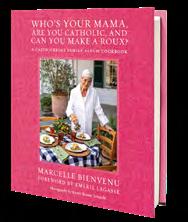
Marcelle Bienvenu is a food writer, food historian and frequent contributor to Rouses Magazine The highly anticipated new release of her timeless classic, Who’s Your Mama, Are You Catholic, and Can You Make a Roux? is a treasure trove of over 200 recipes, revised with a foreword by Emeril Lagasse and sumptuous color photography capturing the essence of every season.
By David W. Brown
Britney Landry never expected to go viral. When she posted her first recipe on TikTok in 2021, to an account she called “britscookin,” the stay-at-home mom was just looking for a creative outlet.
Her youngest son had recently started school, so she had a little extra time on her hands. She loved watching videos of home influencers. She cooked every day anyway, so she figured: Why not record it?
She made a pastalaya for the video — “A busy-mom meal,” she told me: a typical weeknight meal, easy to throw together, and with easy cleanup because it’s a one-pot recipe. Even better, it makes a big meal inexpensively. She didn’t have any fancy cameras or microphones. She recorded it with her iPhone, added background music from the app, and tapped the post button. She didn’t even speak in the video.

To her astonishment, the video got thousands of views. During COVID, it seemed like everybody was getting famous on social media, but she didn’t think it was possible anymore. And yet the views and followers kept ticking upward. It felt a little surreal; all the messages from people, everyone asking her for recipes. A little light bulb went off in her head: Maybe there was something to this.
She decided to post another video. Her family was going crabbing at Pecan Island, and she made a recording of the packing of the ice chest with ham sandwiches and the boiling of the crabs when they got home. It was a little family vlog and, again, the views kept going up and up. Landry decided to see how far this thing could take her. She started posting a new recipe every day.
“I try to post mainly recipes because that’s what I’m good at, but every now and then I will post my family and me on vacation, and things like that,” she said. For those first few videos, she was just trying to navigate what people wanted to see. She tried to base her recipes off what was on sale at the grocery store that week.
Landry grew up in New Iberia, Louisiana, next door to her grandmother, Cevrila “Tut” Alleman, a fantastic cook who worked in the school cafeteria. Every day after getting off the school bus, Landry would stop by to see what her grandma had to eat. “It was never snacks out of the cabinet,” she said. “It was always something like rice and gravy — a home-cooked meal.” Sometimes, her grandmother would bring home those big school cinnamon rolls, if there were any left over, and every Sunday they had a big family meal.
more than 1.6 million followers there, and another 1.3 million on her Instagram account, britscookin.
“I do a lot of authentic Cajun dishes like catfish court-bouillon,” she said. One of her first viral posts was fried eggs over rice. “Growing up, everything was always over rice, so I still do a lot of rice dishes.”
You’ll also see a lot of corn on her channel. Her grandfather grew corn and, as a family, they would pick it, shuck it and store it in the freezer. Things like corn maque choux were a staple yearround (you can find that video on her channel as well).
Her buttered noodles dish was her first truly viral video. “I like it because anybody could do it. Even my son could do it! It’s the seasonings and things that I use, I feel, that make it special.” Her two young sons, ages seven and 10, think their mom’s celebrity is “supercool,” and now they want to be YouTube stars when they grow up.
Landry has a lyrical Cajun accent, and when she began adding voice-overs to her videos, her channel really took off. “People were so intrigued by my voice,” she said. “I think a lot of people followed me in the beginning just because of the way I talk.” She attri butes her success, in the long run, to authenticity.
“ALLONS MANGER!”
Though Landry didn’t know it at the time, those dishes were precisely the sorts of things she would one day prepare on her TikTok channel, where her subscriber numbers just kept climbing. Today, she has


“Just being true to yourself is really important,” she said. “Don’t try to be anyone you’re not. When I make something that my grandma would cook, I might mention that, and people really seem to appreciate it. A lot of comments I get are people sharing the way their grandmothers would make the dish.”
The length of time it takes to record a video varies. The buttered noodles video took 10 minutes to make; gumbo would take a couple of hours. After completing her videos, she edits them, condensing them down, putting clips in the proper order and recording her voice-overs. In all, the process takes about two hours.
She knew she’d made it when brands began reaching out for advertising. The first one she worked with was Tabasco. “It was a strange experience,” she said, “because how do you know what to charge?”
None of her success feels real to her. “It’s like I’m in la-la land,” she said with a laugh. “It truly means so much to me when people come up to me and tell me how they tried my recipes. One girl told me that her mom died at an early age, and she was never able to learn how she cooked. She said that I’m teaching her how to do all the recipes she remembers eating as a kid. I never would have dreamed that I would be the person who taught someone how to cook.”
Today, she still shops the sales and tries to base her videos on that, but she’ll also switch things up and make seasonal dishes. “I try to be strategic with it. So, in the summertime, I’ll post cold desserts. But right now — even though it’s still really hot outside — people are looking forward to fall, and everybody’s posting Halloween things. So, I recently posted a soup. I’m also trying to focus on quick, 30-minute, one-pot meals for moms that have kids in sports this fall — things you can do before taking your kids to games or practice.”
And though a majority of her gravy dishes, for example, are things she grew up on, she’ll also follow social media trends. “I mean, you have to keep up with the times. Every now and then, something will trend on TikTok and I’ll do that. I recently made smashburger tacos — I got the ingredients for them from Rouses. They had a great sale on meat.”
As Landry’s brand has continued to grow, she’s been approached about writing a cookbook, something she long balked at (“I was like, people are not going to buy my cookbook!”). And she recently started a line of seasonings, something her husband thought would be really successful. But all that is a distant second to her work at home.
“I’m a full-time mom, and I tell everybody that this will never get in the way of that. If one of my kids’ teacher needs me to go sit with a class, I always want to be able to do that. And at any point, if this got in the way, I wouldn’t do it anymore.”
Still, she said, food will always be her creative outlet. “Food makes people happy. Food brings people together.” And now, she’s not just bringing joy to people in her kitchen. She’s bringing joy to people around the world.
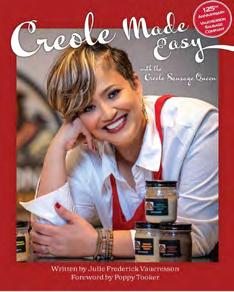
ARROW-CIRCLE-RIGHT The Creole mystique of New Orleans is deliciously celebrated in Julie Vaucresson’s new book, Creole Made Easy. Married to Vance Vaucresson for the past 25 years, she is also known as Julie V, the Creole Sausage Queen. The family’s 125-year-old Vaucresson Sausage company is well-known as the last of the original Jazz Fest vendors. Their hot sausage po-boys are part of countless fest-goers’ traditions.
In Creole Made Easy Vaucresson provides a glimpse into the Creole culture and cuisine of New Orleans’ Seventh Ward. Vaucresson Sausage has always been located on St. Bernard Avenue in the heart of that unique neighborhood. Vaucresson’s grandfather, Rivers Frederick, founded Louisiana Life Insurance and Louisiana Undertaking in the Seventh Ward as well.
Her mother Josette Frederick was a young widow raising four children alone on a schoolteacher’s salary, but she made sure her family sat down together each night for a delicious homemade meal. Sunday dinner was always something special. From crab pie to candy apples, Vaucresson’s childhood favorites are included in the book.
Creole Made Easy will have amateurs cooking like pros, while the most seasoned kitchen veterans are sure to find something new and inspiring between the pages.
ARROW-CIRCLE-RIGHT This Picayune favorite dishes out Southern comfort food with a rotating menu. Monday’s special is red beans with fried or grilled pork chops, while other daily offerings include Cajun baked chicken, butter beans and rice with smothered pork chops, and Friday seafood specials topped with their special Stella crawfish cream sauce.
ARROW-CIRCLE-RIGHT Family-run since 1993, Rita Mae’s Kitchen serves up authentic Cajun cooking and homestyle plate lunches. The daily specials are popular, with the stuffed bell pepper being a standout dish. This cozy spot has a loyal following, so arriving early is key.




























Only about 19% of domestic violence shelters accept pets. Purina® wants to change that with the Purple Leash Project. Shop a variety of nutritious and delicious dry and wet foods from the brand that supports domestic abuse survivors and their pets. At Purina® , your pet is our passion.


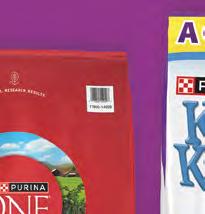





















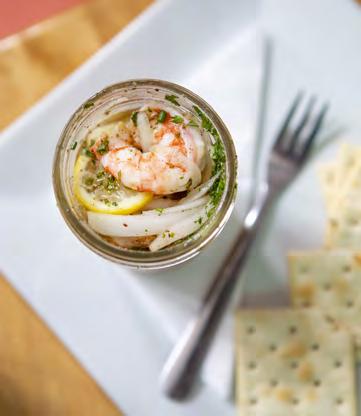
by Susan Langenhennig Granger
For those of us lucky enough to live in the Gulf South, here’s a head-shaking statistic: About 80 percent of the seafood eaten in the United States comes from abroad, “primarily from Canada, Chile, India, Indonesia and Vietnam,” according to the U.S. Department of Agriculture.
Given the bounty of fresh, seasonal seafood pulled from the waters just off the coasts of Louisiana, Mississippi and Alabama, it’s easy to utter “Bless their hearts” when you think of the unfortunate diners around the country eating seafood shipped in from parts unknown.
As trendy and almost commonplace as the label “farm to table” is these days, it is still shocking how much food prepared at restaurants comes to the plate on a route far more circuitous than direct from a local farm or fishing boat.
In short, eating local is still a noble cause.
And that’s what quietly drives the menu at The Noble South, the 10-year-old acclaimed eatery in Downtown Mobile. It’s not a gimmick or a trend. It’s actually old school, returning to Southern traditions, when eating local was the only option — but approached with modern sensibilities. It’s also a way to provide the freshest, most nutrient-rich food on the table, said Noble South’s Chef/ Owner Chris Rainosek.
“We’re not the only restaurant using local (seafood and produce), but over the last 10 years, the main thing that has differentiated
us is, we build from the produce out,” he said. “We see what is available and start at that point,” not the other way around.
In late summer, that can mean Alabama peaches (showing up recently on the menu in a semifreddo with a brown butter-pecan cookie), rock shrimp curry (appearing with Louisiana rice, late-summer vegetables and herbs), and a bouillabaisse straight from the boat, with local catfish, shellfish, shrimp and artichoke, and served with Anson Mills Grits (a mill specializing in heirloom grains from South Carolina, a little further afield, but still in the South).
“Being a little nimble and light on our feet, we print our menus in-house daily, and we can work on the fly a little bit,” Rainosek said. The 52-seat restaurant aims to use produce and proteins that come from within a two-hour radius of Mobile. Being geographically focused offers benefits — the freshest fruits and vegetables — but also the occasional challenge, like when a storm washes out a crop and upends fisheries.
“Things pop up — weather-related, lastminute outages — but we have open lines of communications with our growers, so we can adjust when we need to,” Rainosek said.
Given the long growing season in the Gulf South, the restaurant has a lot to work with. “The late spring and summer, there are so many options, like squashes, tomatoes, okra, corn: All these things relate to traditional Southern food,” he said. “But as we move into the winter season, I love the citrus that is available, and it allows us the opportunity to get into the hearty greens, with the citrus giving us the opportunity to brighten things up a bit.”
Rainosek started building relationships with several local farmers when he was the executive chef at The Wash House, another farm-to-table restaurant in Point Clear, Alabama. “That’s where I really fell in love with the farm-to-table concept because in Baldwin County, it’s a farming community,” he said.
“I was driving by all these farms, seeing what they had; then after a while I had a few (farmers) start to knock on my door,” Rainosek continued. “A lot of them were willing to sell you 10 pounds of something, and then they would say, ‘What could we grow for you?’”
“We’re not the only restaurant using local (seafood and produce), but over the last 10 years, the main thing that has differentiated us is, we build from the produce out. We see what is available and start at that point.”
– Chris Rainosek, The Noble South’s Chef/Owner
Working with seasonal produce also helped provide some beneficial limits to his culinary inclinations, he joked. “If I had the whole world available to me, I’d never get anything done; I need some focus. People get excited about the seasons changing, and I like the way that works.”
Rainosek spent his youth in Mobile, and then earned a bachelor’s degree in political science from the University of Alabama before heading to Colorado. It was there that he got into the restaurant business, first in the front of the house, before going to the Culinary School of the Rockies.
After culinary school, he eventually moved back to Alabama. “It seemed like a nice place to raise a family, buy a house,” said the chef, who has two children, ages 13 and nine, with his wife Lesley.
Between the restaurant and a busy family life, Rainosek and his wife share cooking duties at home. “We have a Rouses by our kids’ school in Spring Hill, and I hit that when I have to scoop up something for the restaurant or home,” he said.
“My wife cooks as well, so we both cook depending on how the schedule is shaking out. She is very recipe-oriented, and I am the guy who comes in and can use up whatever we have. I tend to not make the same thing twice. I’m a little more improv.”
Whatever it is, though, it was likely grown within a two-hour radius of home.
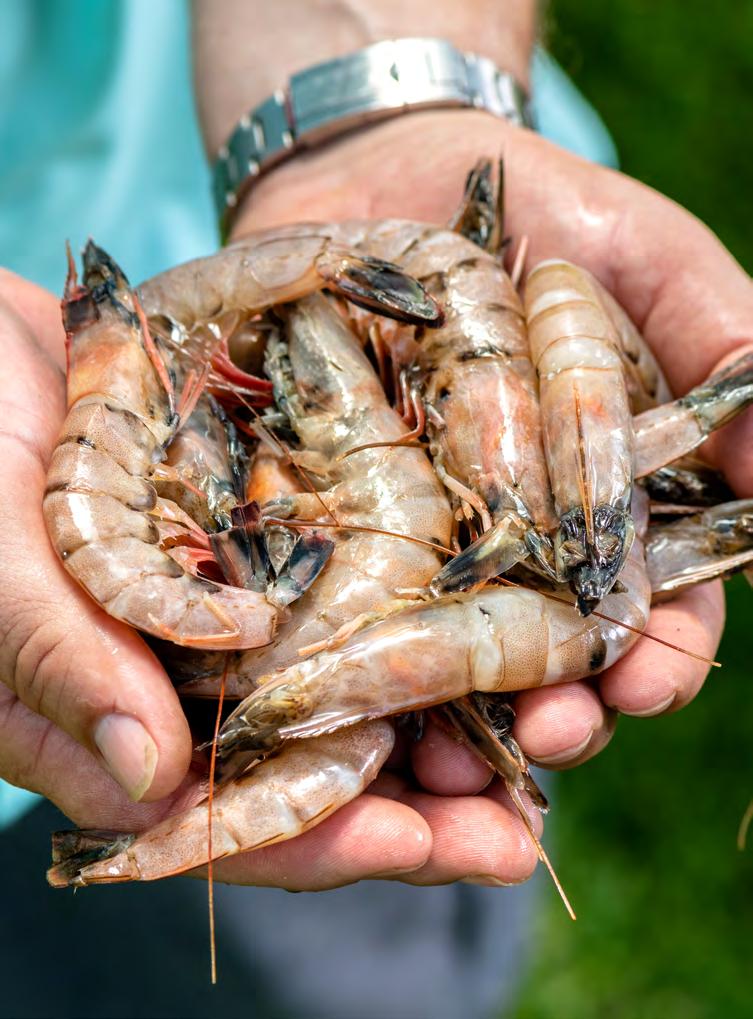

ARROW-CIRCLE-RIGHT Chef Chad Kirtland proudly represents Rouses Markets on the “In the Kitchen” cooking segment of Studio 10, the Gulf Coast lifestyle show on WALA FOX 10 News in Mobile, Alabama, hosted by Joe Emer and Chelsey Sayasane. A New Orleans native, Chef Chad sharpened his culinary skills while studying at Loyola University and working in some of the city’s top restaurants. Despite his career as a full-time journalist and editor, his passion for cooking never wavered, leading him to cater parties and dinners for friends and family. This eventually inspired him to launch his own catering company in Fairhope. Now, Chef Chad shares his love of Southern cuisine — and Rouses Markets — with viewers every Tuesday and Thursday morning on WALA FOX 10.
ARROW-CIRCLE-RIGHT I’ve been fortunate to spend a good bit of time in the Lowcountry region of Georgia and South Carolina, in places like Savannah, Beaufort, Charleston and Pawleys Island. East of these towns, out to the Atlantic, the land dissipates into grassy marshes and tidal ponds. Sea salt hangs in the air. It feels…coastal. This region is also the birthplace of one of my favorite dishes: shrimp and grits.
Growing up in South Louisiana, I loved a debris po-boy more than almost anything; shrimp and grits wasn’t even on my radar. But once I found it, I was hooked. I wanted to try every version I could find. If shrimp and grits was on the menu, that’s what I was having.
It took me several years to develop my own shrimp and grits recipe, tweaking each ingredient along the way. I use the thickest possible bacon. Half smoked Gouda, half extra sharp cheddar (white, not yellow) for the cheeses. Just a few drops of citrus. Some Tony’s and a bit of Old Bay. You get the idea. These small details make a difference to the dish. They make it mine.
– Chef Chad Kirtland
ARROW-CIRCLE-RIGHT We can’t wait to visit White Pillars Restaurant when our Biloxi store opens in mid-October! Owned by Chef Austin Sumrall and his wife, Tresse, White Pillars is a James Beard-nominated, farm-to-table restaurant located in a beautifully restored beachfront home. They pride themselves on sourcing the best seasonal ingredients from local farms, which means their menu changes almost daily.
Makes 4 servings
Debris (pronounced duh-BREE) refers to the tender bits of beef that fall off a roast into the pan drippings and gravy while the roast is cooking in the oven. In New Orleans, it is often served on poboys, but I like it over grits.
WHAT YOU WILL NEED:
4 cloves of garlic, diced
1 (4-pound) boneless chuck roast, trimmed
1½ teaspoons kosher salt
1 teaspoon freshly ground black pepper
1 teaspoon garlic powder
3 tablespoons canola oil
1 medium yellow onion, sliced
4 cups beef broth
1 tablespoon Worcestershire sauce
1 bay leaf
½ teaspoon dried thyme
1 teaspoon hot sauce
HOW TO PREP:
Preheat the oven to 325°F.
Using a sharp paring knife, make small cuts, about 1½ inches deep, all over the chuck roast. Insert garlic chunks into the cuts.
Generously season the roast on all sides with salt, pepper and garlic powder.
In a Dutch oven or large skillet, heat oil over high heat. When oil is hot, sear the roast until it is dark brown on all sides, 4 to 6 minutes per side. Set roast aside.
Place sliced onions in the Dutch oven and cook for 1 minute.
Add beef broth, Worcestershire sauce, bay leaf, thyme and hot sauce. Stir. Bring to a boil, then reduce heat to low. Simmer for 3 minutes.
Return roast to the Dutch oven. Pour the liquid mixture over the roast.
Cover the Dutch oven with a lid and place it in the preheated oven; bake the roast for at least 3 hours. The roast is ready when the meat is fork tender and falls apart easily.
Transfer roast to a cutting board; let it rest for 10 minutes.
Return the Dutch oven to the stove. Bring the liquid in the Dutch oven to a boil over medium-high heat and cook until reduced by half. Remove from heat. Shred the beef and mix it back into the liquid in the Dutch oven. Spoon beef and gravy over grits and serve.
Makes 4 servings
WHAT YOU WILL NEED:
For Grits:
1 cup chicken stock
1 cup whole milk
1 cup grits (Old Fashioned, not 5 Minute)
4 tablespoons butter, divided
1 cup white extra sharp cheddar cheese, shredded
1 cup smoked Gouda cheese, shredded
1 tablespoon salt
2 tablespoons black pepper
For Shrimp:
4 strips of thick cut bacon
1 pound large (21/25) shrimp
Creole seasoning to taste
Old Bay seasoning to taste
2 tablespoons butter
2 tablespoons flour
1 shallot, minced (about ¼ cup)
½ tablespoon garlic, minced
½ cup shrimp stock (or chicken stock)
1 teaspoon Louisiana Hot Sauce
½ teaspoon lemon juice
Green onions, chopped (for garnish)
HOW TO PREP:
For Grits:
Combine stock, milk and 2 tablespoons butter in a saucepan. Add a pinch of salt. Bring to a boil.
Add grits and whisk until it begins bubbling. Reduce heat. Simmer for 10-15 minutes. Add more milk as needed to maintain smooth, creamy consistency. Whisk regularly.
Remove grits from heat. Add 2 tablespoons butter cut into small pieces. Stir until smooth. Add cheddar and Gouda, and stir to combine.
Season with salt and pepper to taste. (I like a lot of black pepper.)
Add butter, milk or seasoning as needed. Set aside.
Transfer to a paper towel-lined plate. Once cool, chop into small pieces. Drain all but 2 tablespoons of the bacon grease, leaving enough to coat the bottom of the skillet.
Reheat bacon grease in the skillet. Once hot, sear the shrimp until barely cooked, about 1 minute per side. Remove shrimp from the skillet and set aside.
Make a small amount of blonde roux by melting 2 tablespoons butter in the skillet with the bacon grease. When it’s hot and bubbling, add flour and stir. Continue stirring until the mixture turns light brown.
Add shallot and garlic and sauté until soft, about 3-4 minutes.
Add shrimp, stock and hot sauce to the skillet. Bring to a boil, then reduce heat to low. Simmer for 5 minutes, stirring every few minutes. For a thick sauce, let the sauce reduce by half. If you prefer a thinner sauce, add more stock ¼ cup at a time, or until it reaches the desired consistency. Remove sauce from the heat and stir in lemon juice.
Place 1 cup of grits in each of 4 bowls. Ladle sauce over grits. Place the shrimp on top. Sprinkle the chopped bacon and green onions on top.
Serve with warm French bread. Enjoy!
For Shrimp:
Rinse shrimp and pat dry with paper towels. Toss the shrimp with the Creole seasoning and Old Bay until coated. Let rest in the refrigerator for at least 10 minutes.
In a cast-iron skillet over mediumhigh heat, cook the bacon until crispy.
ARROW-CIRCLE-RIGHT Named after chef/owner Paul Chauvin Dupré’s grandmother, this Mid City spot has been serving Cajun favorites since 2017. With savory options like crawfish hand pies and Louisiana poulet pot pie, plus sweet pies for dessert, Elsie’s Plate & Pie is a go-to for comfort food with a personal touch.
ARROW-CIRCLE-RIGHT In 1964, Frank Dedman Sr. and his wife Carolyn opened their first Baton Rouge restaurant, originally named the Blue Bird Drive-In, just across Airline Highway from Frank’s current location. Frank proudly proclaimed his light, creamy buttermilk biscuits as “the best homemade biscuits in the world.” Today, three generations of the Dedman family own and operate the Baton Rouge location, along with another in Prairieville, serving up signature home-cooked meals and offering breakfast all day.
ARROW-CIRCLE-RIGHT For 26 years, this unassuming, casual Southern and Creole restaurant in the Bywater neighborhood has been serving up breakfast and lunch gems to tourists and locals alike. While Elizabeth’s is famed for its praline bacon, it also serves up some scrumptious homemade biscuits with a classic Southern sausage gravy.
ARROW-CIRCLE-RIGHT Gaylon H. White’s The Best Little Baseball Town in the World tells the intriguing story of the Crowley Millers, a minor league baseball team in 1950s Crowley,
Louisiana. The book highlights quirky characters like slugger Conklyn Meriwether, who became infamous after he retired when he killed his in-laws with an axe, and a con-man manager who died in jail. Despite tragedy, such as a player’s death by lightning strike, the team produced stars like George Brunet and Dan Pfister. White’s interviews with players offer insight into the era’s baseball culture, and the book even includes a recipe for the biscuits served at the old Crowley Greyhound Bus Station. Available online and in bookstores.
The biscuits at the Greyhound bus station coffee shop in Crowley were as popular as the Millers baseball team, with people lining up for a slice of heaven every morning at seven o’clock. Little Richard, the rock-and-roller, reportedly loved the biscuits and indulged in them whenever he was in the area.
This recipe comes from Fred Reggie, nephew of Judge Edmund Reggie, a longtime Crowley city judge and political stalwart in Louisiana.
“Back in the days when the biscuits were baked in a rectangular pan and cut into little squares, I remember I would always request the corners because of the two crispy edges,” Fred wrote in a Facebook post. He claimed the recipe is the real deal and will make you feel like you’re sitting in the Crowley bus station.”
CROWLEY GREYHOUND BISCUITS
Makes 9 large biscuits
WHAT YOU WILL NEED:
2 cups flour
Pinch baking soda
½ cup sugar
2 heaping teaspoons baking powder (Clabber Girl)
1 teaspoon salt
1 cup buttermilk
½ cup Crisco, melted
½ stick butter or margarine, melted
HOW TO PREP:
Preheat oven to 450°F. Mix all dry ingredients. Add half of the buttermilk, then Crisco (let cool slightly until almost thickened before adding), then add the rest of the buttermilk. Mix well. Knead a few times on a floured board (dough will be sticky — add a little flour but handle as little as possible). Spread dough gently in an 8” x 8” or 9” x 9” pan. Place in preheated oven and bake for 15-20 minutes or until brown. Remove from oven and pour the melted butter over biscuits before serving.

— Gaylon White, author, The Best Little Baseball Town in the World
ARROW-CIRCLE-RIGHT Famous for its hot and fresh doughnuts, Butter Krisp Diner sold over 13,000 doughnuts the day it reopened after storm damage. In addition to doughnuts, the diner serves all-day breakfast and burgers, with inventive mash-ups like donut breakfast sandwiches, grilled cheese donuts, and donut burgers.
GOOD EATS CAFÉ, SLIDELL, LA
ARROW-CIRCLE-RIGHT This mom-and-pop spot in Slidell is beloved for its homemade everything. Breakfasts — especially the home fries — are legendary, and the home-cooked lunches keep the community coming back for more.
ARROW-CIRCLE-RIGHT
Our Houma da Chicken drive-thru restaurant at the Rouses Market in Houma, located at 2233 Martin Luther King Blvd., lets you pick up our famous fried chicken without ever stepping foot inside the store. Doublebattered and made using a Rouse Family Recipe passed down through three generations, our chicken is fried fresh throughout the day. And don’t forget the star of the meal — our flaky, dense, bayou-size biscuit!

ARROW-CIRCLE-RIGHT In 2008, Natchez earned the title of Biscuit Capital of the World, largely thanks to renowned local chef Regina Charboneau. Dubbed the “Biscuit Queen” by The New York Times, Charboneau is the one-time owner of Twin Oaks Bed & Breakfast in Natchez, Mississippi, who now operates Regina’s Kitchen Cooking Classes in Natchez. She’s also the author of several cookbooks. Despite covering just 16 square miles, Natchez is home to more than 1,000 buildings listed on the National Register of Historic Places.
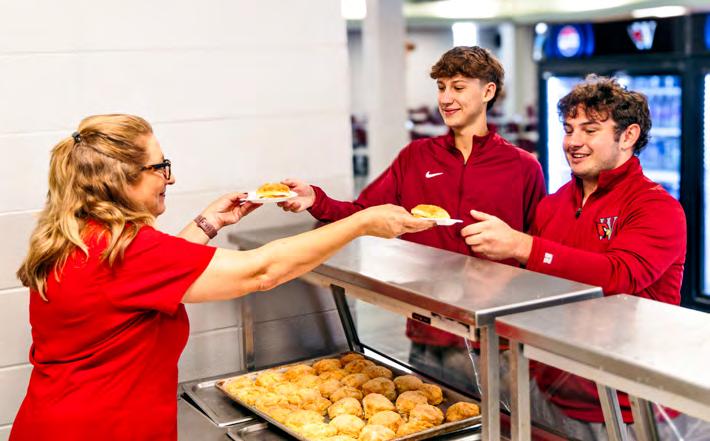
ARROW-CIRCLE-RIGHT The biscuits at Edward Douglas White Catholic High School in Thibodaux have reached nearlegendary status; they’re so good, they make you wonder if cafeteria food has always been this delicious or if you’ve just been missing out.
Marie LeBlanc, the Food Services Supervisor, holds an associate’s degree in dietetic technology/ food service management and has overseen the cafeteria for nearly 32 years. “My oldest was four and my second was six months when I started,” Marie says. “Now I have a granddaughter here, and the next one will be here next year.”
Before Marie arrived, there was no cafeteria at E.D. White. “Kids used to have to bring their lunch,” she recalls. The biscuits were her idea, brought over from a previous job. Made fresh daily — plain, egg and cheese, or with bacon or sausage — they fly off the line starting at 7 a.m. “By recess at 9:45 a.m., it’s rare to have any left.”
The biscuits are hand-cut and baked on trays of 35. They spread as they bake, which makes them huge. Crisp on the outside, soft and fluffy on the inside, they’re drenched in margarine before and after their time in the oven. “When someone asks for butter, I tell them, ‘No, you don’t need any.’”
Marie’s team includes “Biscuit Lady” Lisa Chiasson, who’s been making them for 30 years. Her daughter Ashley has been alongside her for nine, and Lilly Steele, another key player, has been at E.D. White for 11 years. Together, they whip up everything from biscuits to red beans and chicken stews for lunch.
The biscuits have become a staple not just for students but for alumni as well. Some even stop by between classes at nearby Nicholls State just to grab one. “I’ll get texts or calls — ‘Miss Marie, can I get an egg and cheese?’ — and I’ll run it out.”
Demand is so high that pans of biscuits are offered during fundraisers and even sent to 7th graders at feeder schools, giving future students a taste of what’s to come. “We donate to St. Joseph, St. Genevieve, and other schools. It’s something special for the incoming kids to look forward to.”
ARROW-CIRCLE-RIGHT Since 1990, this beloved Lafayette breakfast spot has been serving up big, fluffy sweet biscuits, savory meat-filled biscuits, hearty breakfast platters and omelets.
“Love Ya Like a Biscuit!”

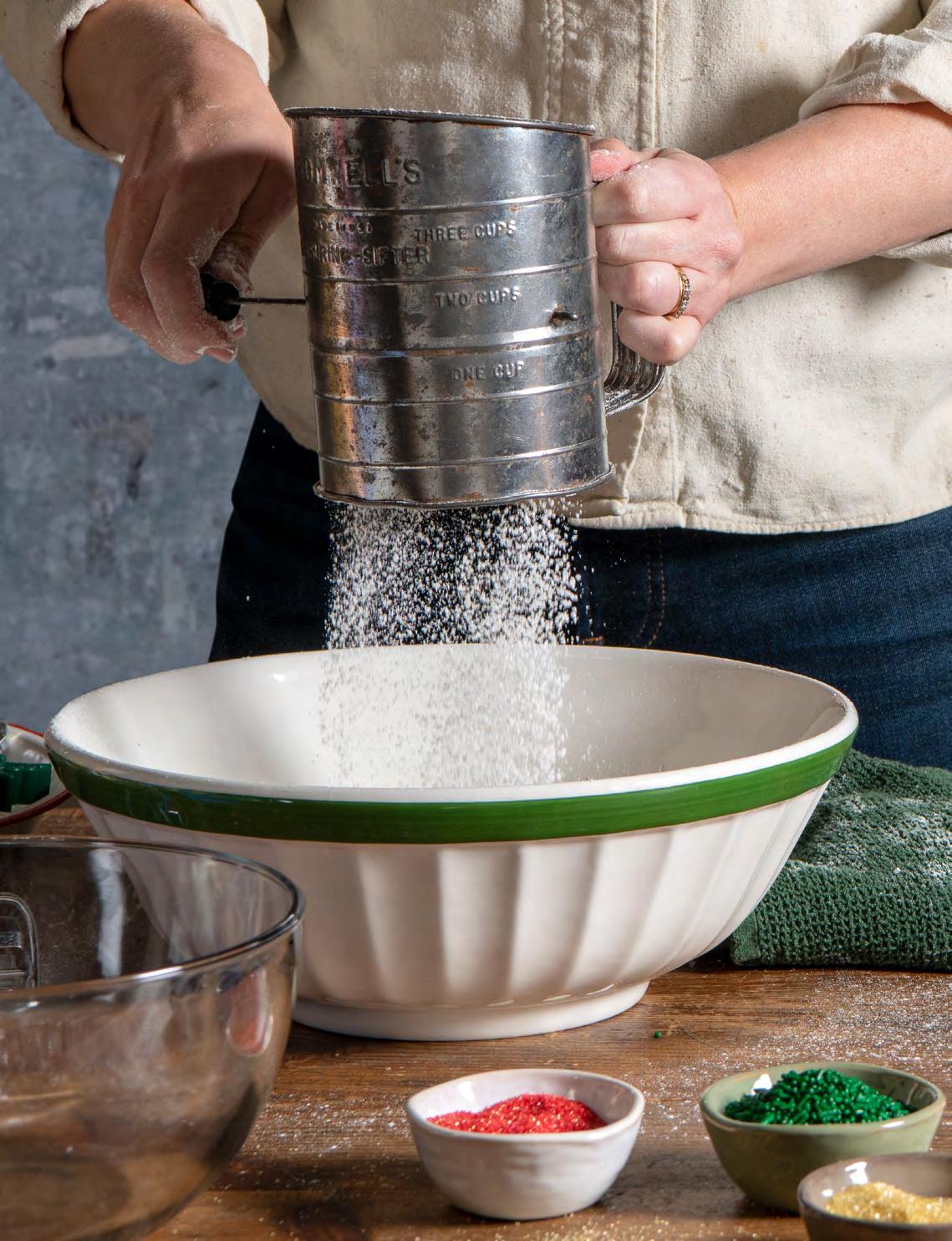
By Ann Maloney
I’ve long been comfortable cooking savory dishes, especially those I learned at my mother’s knee in our New Orleans kitchen. I can toss together an étouffée, whip up a red gravy or throw together a sheet-pan dinner with the confidence of a WNBA all-star slipping into a neighborhood pick-up game.
When it came to baking, however, I often felt more like a tween navigating her first school dance: unsure, awkward and full of anxiety. I’m more confident these days, but I still get the stress that can descend around the holidays when folks are suddenly called upon to bake cookies, pies or dinner rolls. The pressure is on!
Over the years, I’ve picked up helpful habits from family, the excellent bakers at The Washington Post where I was recipes editor, top-notch New Orleans bakers when I was a food writer at The Times-Picayune, as well as from trusted cookbooks and online sources.
Below you’ll find a half dozen common baking dilemmas and the solutions I’ve adopted. Do I still have a lot to learn? Of course, but these tips have helped me build my baking confidence. I hope they do the same for you.
Ban PROBLEM: Oops! I didn’t know I needed that.
Check-circle SOLUTION: Read the recipe carefully.
ARROW-CIRCLE-RIGHT Never skip this step! Mentally walk through the recipe, asking yourself: Do I have the equipment and ingredients I need? Did I factor in the rising time, chilling time? Does the recipe offer cooking times and visual cues? After reading it, ask yourself: Do I still have questions? If the answer is yes, the recipe might be the problem. Look for something similar from a cookbook or from a site featuring tested recipes. (The internet has many untested recipes!) Bonus tip: Unless you’re experienced, don’t assume you can substitute one ingredient for another or use a cooking vessel other than the one called for.
Ban PROBLEM: Sometimes this recipe works; sometimes it doesn’t.
Check-circle SOLUTION: Get a reliable kitchen scale.
ARROW-CIRCLE-RIGHT I grew up using the scoop-and-level method of measuring dry ingredients, so I was resistant to using a scale. It is, however, the most important baking habit I’ve adopted. Baking involves science, and a scale allows you to be precise. Don’t believe a scale is necessary? Try measuring flour two ways: Reach in and scoop it into the measuring cup; weigh that. Then, gently spoon flour into the cup and weigh that. You’ll likely see a 20
percent difference in the weight. Multiply that by multiple cups and you can see how this could affect results. If your recipe doesn’t include weights, weigh any ingredient of ¼ cup or more as you go, so you can make adjustments.
Ban PROBLEM: Whoa, it’s burnt at the edges and raw in the middle.
Check-circle SOLUTION: Check your oven temperature, and your pan size and material.
ARROW-CIRCLE-RIGHT An inaccurate oven can cause all sorts of mischief. Use an oven thermometer to check the appliance. Also, even when your oven dings, it still may not be fully preheated. A thermometer can let you know where you stand.
When it comes to pans, make sure you are using the size, shape and material called for. Often a recipe will give you a size, but not the material. If you have a choice, many experts agree that metal, which heats up and cools down evenly and quickly, is better for baking. With glass, the edge of the food may start to crisp before the center is cooked. (Only have glass? Try tenting the edges with foil if they cook too quickly; or wrap the outside of the pan in a damp towel or baking strips.) And don’t just rely on allotted cooking time. You want to limit opening the oven but, near the allotted time, look for visual cues: Is it golden? Does the cake spring back when touched? Does a skewer inserted come out clean?
Ban PROBLEM: My cakes (or cookies) are flat and dense.
Check-circle SOLUTION: Pay attention to ingredient temperatures.
ARROW-CIRCLE-RIGHT Recipes often call for room temperature butter and eggs. (That’s around 70°F. In the South, there’s no telling how hot your kitchen might be, right?) The reason? They will combine smoothly with the other ingredients, allowing you to incorporate the proper amount of air and create an even texture and volume. Butter too cold? Your cake might crumble due to uneven mixing, or the batter may become tough because you had to overmix. Too soft? You may end up with flat cakes and cookies. Cold eggs can curdle a batter, leading to a denser texture. Didn’t have time to remove these items from the fridge? Soften butter in a microwave: Stand the stick on its end and start with 10 seconds of heat. Feel the butter. It should be soft enough for your finger to leave a slight dent, with no melting. Still too firm? Try another 3 seconds… (If your butter is not in stick form, rotate it after each hit of heat.) For the eggs, place them in a bowl of warm-from-tap water for about 5 minutes.
Ban PROBLEM: Yikes! My luscious batter turned to soup!
Check-circle SOLUTION: Master basic baking mixing techniques.
ARROW-CIRCLE-RIGHT You can get your butter to the exact temperature and measure each ingredient perfectly, but if you don’t mix
it properly, you can undo that careful work. If the recipe says to mix just until the ingredients are incorporated, be gentle and do just that. Chances are, you’ll also come across one of these terms:
• Beat: Beating means to vigorously mix an ingredient or combination of ingredients together, usually with a fork, whisk, wooden spoon or electric mixer.
• Cream: Here, you beat the fat (usually butter) and sugar together to incorporate air and create a fluffy, pale mixture. This is usually done with a whisk or electric mixer.
• Fold: Most often, this involves adding whipped egg whites or cream to a batter with the goal of retaining air and volume. To fold, add the fluffy ingredient to the batter and then, using a rubber spatula on its edge, cut down the middle of the bowl, scoop the batter from the bottom, and bring it up and over in a gentle circular motion. Rotate the bowl as you go and continue until the mixture has no streaks. If the batter is very dense, you can start by adding about a third of the fluffy mixture, incorporating that first and stirring gently, then adding the rest.
Ban PROBLEM: Oh no! It stuck to the pan.
Check-circle SOLUTION: Grease and line the pan properly.
ARROW-CIRCLE-RIGHT Generally, follow the instructions in the recipe. (For some, such as angel food cake, pans should not be greased at all.) In most cases, however, even if using a nonstick pan, greasing helps to ensure success. The key is even but not excessive coating.
The most flavorful choice is butter, but you may use oil or cooking spray. For butter, cut off a tablespoon and rub it around the pan, letting the warmth of your hands soften it as you go. Flouring the pan adds another layer of insurance. Add a tablespoon or so of flour and then turn the pan to get a dusting on the bottom and sides. Tap the pan to loosen any clumps and then turn it over and tap out any excess.
Even if a recipe doesn’t call for parchment, for extra insurance, especially with cakes, grease the bottom of the pan,
press in cut-to-fit parchment and then grease the pan as directed above. If you want to lift a cake or bar cookies out of the pan, parchment can help there, too. Cut it longer on two sides to create a sling so you can easily lift out the baked goods.
Note: The best tried-and-true recipes often come from family and friends. When I asked my pal and fellow food writer Suzy Fleming Leonard for an easy dinner roll recipe, she immediately used her phone to snap a photo of a yellowed newspaper clipping of a recipe from the Associated Press. “I’ve had it forever, and it’s delicious,” she said. She makes it for holiday meals and gets raves. It is a great one for beginning bakers because the dough comes together quickly in a stand mixer. The pumpkin purée adds flavor and moisture for a tender crumb; the pepitas add crunch. We tweaked the recipe a bit, adding nutmeg and cinnamon for a more seasonal fall flavor. Use canned pumpkin or, if you prefer, puréed butternut squash. The recipe can be doubled, but if you do that, consider starting with 5½ cups of flour, adding more as needed. If toasting the pepitas, add them to a dry skillet over medium heat and stir them until lightly browned and fragrant, about 5 minutes. Cool them to the touch before adding to the dough.
TOTAL TIME: 3.5 hour
SERVES: Makes 12 rolls
STORAGE: Cool completely and store in an airtight container at room temperature for up to 2 days. Reheat uncovered, in a 300°F oven for 10 minutes, or until warm. MAKE AHEAD: The dough can be shaped, placed in the pan, tightly wrapped in plastic wrap and then aluminum foil, and frozen for up to 3 months. When ready to bake, thaw in the refrigerator for 24 hours, then let rise for the second time and bake as directed.
3 cups (375 grams) all-purpose flour, plus more as needed
½ cup (120 milliliters) milk, any fat percentage
½ cup (110 grams) pureed pumpkin (see note above)
4 tablespoon (½ stick, 56 grams) butter, at room temperature
¹⁄₃ cup (65 grams) granulated sugar
1 large egg, at room temperature
1 ¼-ounce packet instant yeast (about 1 heaping tablespoon)
1 teaspoon fine salt
¹⁄₈ teaspoon ground cinnamon (optional)
¹⁄₈ teaspoon ground nutmeg (optional)
½ cup pepitas, toasted
2 tablespoons melted butter, divided
In the bowl of a stand mixer fitted with a dough hook, combine the flour, milk, pumpkin, butter, sugar, egg, yeast, salt, cinnamon and nutmeg. Mix on low speed until combined, scraping down the sides as needed, then increase the speed to medium-low and mix until dough is soft and pulling away from the sides of the bowl, about 5 minutes. If the dough is too sticky, add more flour, 1 tablespoon at a time. Add the pepitas and mix until incorporated into the dough. Cover the bowl with a kitchen towel and allow to rise in a warm spot until doubled, 1 to 1½ hours. Coat one 9-inch cake pan with cooking spray.
Lightly dust a counter with flour. Lightly flour your hands and turn the dough out onto the surface. Divide it evenly into 12 pieces and gently roll each piece into a ball, lightly dusting your hand with flour as needed. (Your total dough should weigh about 810 grams, so each ball should be about 67 grams, or about the size of a billiard ball. For more uniform rolls and to encourage the best rise, create a “gluten cloak” by pulling the top of the dough down and around each ball before pinching and sealing underneath.) Arrange the balls in the prepared pan. It’s OK if they touch. (At this point, the dough can be frozen; see make-ahead note above.)
Cover with a kitchen towel and let rise until rolls have puffed to just above the edge of the pan, about 45 minutes. After the rolls have risen for about 30 minutes, position a rack in the middle of the oven and preheat to 350°F.
When the rolls are fully risen, brush them with 1 tablespoon of the melted butter. Bake for 25 minutes, or until golden with a firm crust on top, rotating the pan about halfway through. Transfer the pan to a wire rack and immediately brush with the remaining butter.
Allow to cool to the touch in the pan and serve warm or at room temperature.
Recipe adapted from an Associated Press recipe.
ROUSE’S COCOONS
These cookies were so popular with the family that Mrs. Rouse would have to put some in a tin and hide it, to guarantee that the Cocoons would be part of a sweets platter on Christmas Day.
TOTAL TIME: About 3 hours
MAKES: 2 dozen cookies
STORAGE: Store in an airtight container for up to 1 week. Separate layers of cookies with parchment or wax paper to prevent them from sticking together.
WHAT YOU WILL NEED:
2 sticks butter
4 tablespoons powdered sugar, plus more for rolling cocoons in
2 cups flour
1½ teaspoons baking powder
½ teaspoon salt
1 teaspoon vanilla
1 cup finely chopped pecans
HOW TO PREP:
Cream butter and powdered sugar together. Set aside.
When ready to bake, preheat oven to 300°F.
Roll dough into crescent shapes and place on ungreased cookie sheets. Place cookie sheets in preheated oven and bake for 25 minutes. Let cool, then roll cocoons in powdered sugar.
A fruit pie is great, but if the hassle of making a pie crust gives you pause, consider an easy-toassemble fruit crumble. This is a great go-to recipe that we have put on repeat for potlucks or when we’re short on time. The make-ahead classic dish can be created with almost any variety of fresh or frozen berry or chopped stone fruit. Frozen fruit is easy to find year-round in your grocer’s freezer case. If using frozen, thaw the fruit in a colander set over a bowl in your refrigerator to keep your crumble from being too juicy.
If you do not have an 11" x 8" x 2" baking dish, the recipe works in a 9" square pan, but may take longer to bake. If using a glass baking dish, skip the broiling step to avoid shattering the pan. If toasting the nuts, add them to a dry skillet over medium heat, and toss and stir them until lightly browned and fragrant, about 5 minutes. Cool to the touch before adding to the crumble.
TOTAL TIME: 45 minutes
SERVES: 8
STORAGE: Refrigerate leftovers for up to 3 days; serve slightly chilled or reheat in a 350°F oven until warm.
MAKE AHEAD: The crumble can be assembled, covered and refrigerated unbaked up to 1 day in advance. If using a glass baking dish, let stand for about 30 minutes to warm up before placing in the hot oven.
WHAT YOU WILL NEED:
For the fruit:
Butter or cooking spray, for greasing the dish
¹⁄₃ cup (77 grams) packed light or dark brown sugar
3 tablespoons (30 grams) all-purpose flour
½ teaspoon ground cinnamon
Zest and juice (about 2 teaspoons) from 1 large lemon
6 cups fruit, such as blueberries, cherries or strawberries (chopped if large), thawed if frozen
For the crumble:
½ cup (70 grams) flour
¼ cup (50 grams) granulated sugar
½ cup (110 grams) packed light or dark brown sugar
¼ teaspoon nutmeg
8 tablespoons (4 ounces or 1 stick) cold butter, cut into ½-inch pieces


HOW TO PREP:
Grease an 11" x 8" x 2” metal baking pan (see note above).
For the fruit: In a large mixing bowl, combine the sugar, flour, cinnamon and zest. Add the fruit and lemon juice, and gently toss together until the fruit is well-coated, but with the berries still intact. Spread the mixture evenly on the bottom of the baking pan. Wipe out the bowl, and use it to make the crumble. If baking immediately, position a rack in the middle of the oven and preheat to 375°F.
For the crumble: In the mixing bowl, whisk together the flour, granulated and brown sugars, and nutmeg. Add the butter; using your fingers, quickly work the butter into the dry ingredients until it resembles coarse crumbs (not too fine). Stir in the oats.
Scatter the nuts, if using, over the fruit. Then evenly scatter the crumble over the top. (The pan can be covered and refrigerated for up to 1 day at this point.)
Bake in the preheated oven until the fruit is bubbling at the edges, 25 to 30 minutes. If you want the topping to be darker, turn the oven to broil for a minute, but watch it carefully to avoid burning. (If using a glass baking dish, skip this step to avoid shattering the pan.)
Serve warm or at room temperature, as is or with whipped cream or ice cream.
TOTAL TIME: Approximately 1 hour
SERVES: 8-10
STORAGE: Refrigerate leftovers for 3-4 days; reheat in a 350°F oven, or microwave individual portions.
MAKE AHEAD: You can shred the cheese and measure the corn ahead of time, storing each separately in the fridge.
WHAT YOU WILL NEED:
¼ pound butter
1 cup onion, chopped
4 eggs, whipped
1½ cups milk
½ cup heavy cream
½ cup yellow medium grind cornmeal
1 cup sour cream
1 tablespoon granulated sugar
1 tablespoon kosher salt, or 1 to 1½ teaspoons table salt
1 teaspoon black pepper
½ pound sharp cheddar cheese, shredded (reserve some for topping)
5 cups corn (fresh, frozen or canned)
HOW TO PREP:
Preheat the oven to 400°F.
Melt the butter in a skillet over mediumhigh heat. Add the chopped onion and sauté until translucent, about 5-7 minutes.
In a large bowl, whisk together the whipped eggs, milk and heavy cream. Slowly whisk in the cornmeal and sour cream until just combined. Stir in the sugar, salt, black pepper and shredded cheddar cheese (reserving a little cheese for the top). Gently fold in the corn. Pour the mixture into a greased 9" x 9" pan. Sprinkle the reserved cheese on top, then cover the pan with foil. Place the 9" x 9" pan inside a larger 11" x 13" dish. Fill the larger dish with water until it reaches halfway up the sides of the 9" x 9" pan. Carefully place the dish in the preheated oven. Immediately lower the heat to 350°F. Bake for 45 minutes, or until the top is golden brown and a toothpick inserted into the center comes out clean. Remove the dish from the oven and allow it to cool slightly before serving.
TOTAL TIME: Approximately 1 hour, 10 minutes to 1 hour, 15 minutes
SERVES: 10
STORAGE: Refrigerate leftovers for up to 3 days; reheat in a 350ºF oven, or microwave individual portions.
MAKE AHEAD: You can bake, peel and dice the mirlitons up to 1-2 days in advance. Store them in an airtight container in the refrigerator until ready to use.
4 mirlitons, halved and seeded
3 tablespoons extra virgin olive oil
8 tablespoons butter
1 medium onion, diced
1 stalk celery, diced
1 green bell pepper, seeded and diced
2 cloves garlic, minced
1 teaspoon dried rosemary
1 teaspoon dried sage
1 teaspoon dried thyme
1 pound medium wild-caught Gulf shrimp, peeled, deveined and finely chopped
½ cup Gulf lump or claw crabmeat, picked over for shells
4 cups diced day-old French bread
2 cups chicken stock
½ teaspoon Creole seasoning
1-2 dashes hot sauce
Salt and black pepper to taste
HOW TO PREP:
Preheat the oven to 350°F.
Rub the mirliton halves with olive oil and place them cut side down on a baking sheet. Place in preheated oven and bake for about 45 minutes, or until fork-tender and the skin peels off easily. Set aside to cool. Once cool, peel and dice the mirlitons into 1-inch pieces.
In a large skillet, melt the butter over medium heat. Add the diced onion, celery and bell pepper, and cook until the onions become translucent, about 5 minutes. Add the minced garlic and cook for another minute.
Increase the heat to medium-high and add the rosemary, sage, thyme and chopped shrimp. Stir frequently for 3-5 minutes, until the shrimp are just cooked. Stir in the crabmeat and cook for another 1-2 minutes.
Transfer the mixture to a large mixing bowl. Add the diced mirlitons and French bread to the mixing bowl with the cooked shrimp and vegetables. Pour in the chicken stock and season with Creole seasoning, hot sauce, salt and black pepper. Stir everything together until well combined.
Spoon the mixture into a large, buttered baking dish. Bake in the preheated oven for 20-30 minutes, or until the top is golden brown. Let the dressing cool slightly before serving.
Chef’s note: For the lightest texture, whip the egg whites and fold them into the sweet potato mixture on the day of baking. If you do this too far ahead, the egg whites may lose their volume.
TOTAL TIME: 1 hour, 45-50 minutes
SERVES: 12
MAKE AHEAD: You can bake the sweet
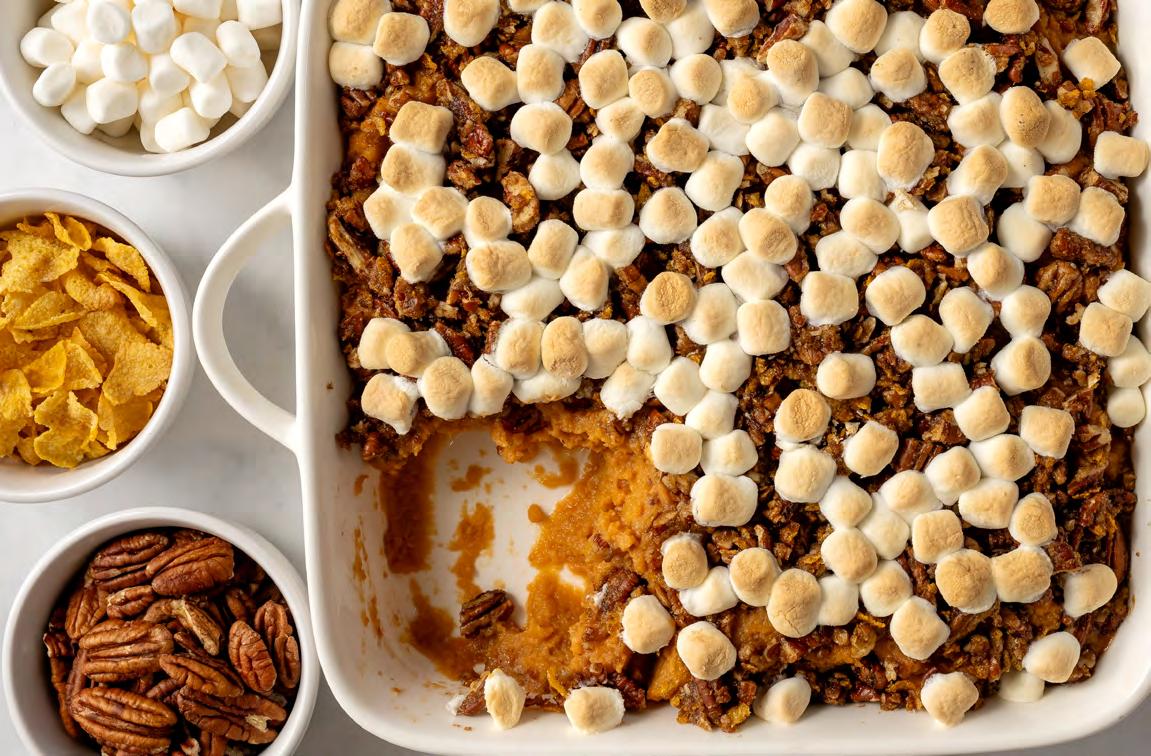
potatoes and peel and mash them with the other ingredients (brown sugar, butter, egg yolks, vanilla and salt) ahead of time. Once combined, store the sweet potato mixture in an airtight container in the refrigerator for up to 2 days.
WHAT YOU WILL NEED:
8 large sweet potatoes
¾ cup brown sugar
¼ pound (1 stick) butter, melted
3 large eggs, separated
2 teaspoons vanilla extract
1 tablespoon salt
2 cups mini marshmallows
Preheat the oven to 375°F.
Wash and pat dry the unpeeled sweet potatoes, then place them directly on the oven rack and bake for about 1 hour, 20 minutes, or until soft in the center. Remove from the oven and allow them to cool slightly. Lower the oven temperature to 350°F.
Once the sweet potatoes are cool enough to handle, peel them and place them in the
bowl of a stand mixer fitted with the whip attachment. Add the brown sugar, melted butter, egg yolks, vanilla extract and salt. Whip until smooth and well-combined. Clean the mixer bowl and whip attachment. Add the egg whites to the clean bowl and whip until stiff peaks form. Gently fold the whipped egg whites into the sweet potato mixture, being careful not to overmix so you don’t deflate the egg whites.
Lightly grease a 9" × 13" casserole dish. Pour the sweet potato-egg white mixture into the dish and smooth the top. Sprinkle the mini marshmallows evenly over the top of the casserole. Bake at 350°F for 20 to 25 minutes, or until the sweet potato mixture has set and is no longer loose. The marshmallows should be golden and slightly toasted. Remove the casserole from the oven and let it cool slightly before serving.
TOTAL TIME: 2 hours, 20 minutes SERVES: 10-12
STORAGE: You can store the cooked Cornbread Dressing in the refrigerator for 3 to 4 days in an airtight container. Allow the dish to cool completely before refrigerating. For longer storage, you can freeze the cooked cornbread dressing for up to 2-3 months. To freeze, wrap it tightly in plastic wrap and aluminum foil or store it in a freezer-safe container. When reheating, thaw the dressing in the refrigerator overnight and reheat in the oven at 350°F until warmed through, or microwave individual portions.
MAKE AHEAD: If you’re using store-bought cornbread (available in our Bakery), you can cube it ahead of time and store it in an airtight container. Stale or day-old cornbread is best for this recipe. You can fully assemble the dressing (minus the chicken stock) and refrigerate it in the 9" × 13" baking dish, covered tightly with plastic wrap or foil, for up to 1 day. Add the chicken stock just before baking. If assembled ahead, let the dressing sit at room temperature for about
30 minutes before baking. Add the chicken stock, then bake as directed.
2 tablespoons canola oil
1 pound smoked sausage, diced
½ pound Cajun tasso ham, cubed
4 tablespoons unsalted butter
4 cups onion, diced
2 cups celery, diced
2 cups green bell pepper, diced
2 tablespoons garlic, minced
1 tablespoon Paul Prudhomme Poultry Magic
1 bunch green onions, chopped
½ bunch parsley, chopped
2 tablespoons sage, chopped
1 quart chicken stock
2 pounds prepared cornbread, cut into cubes
Heat the canola oil in a large pan over medium-high heat. Add the diced smoked sausage and cook for about 5 minutes to render the fat. Add the cubed tasso and cook for an additional 2 minutes. Remove the sausage and tasso from the pan, reserving the fat; set the cooked meat on a plate lined with paper towels to absorb excess grease. Add the butter to the reserved fat in the pan and heat until melted. Add the diced onion, celery, and bell pepper to the pan and cook over medium heat. Scrape the bottom of the pan to release the fond, adding a little chicken stock if necessary to loosen any stubborn bits. Cook until the vegetables are caramelized, about 8-10 minutes. Stir in the minced garlic and Paul Prudhomme Poultry Magic. Cook for an additional 2 minutes.
In a large mixing bowl, combine the cubed cornbread, cooked sausage and tasso, vegetables, green onions, parsley and sage. Toss everything together until thoroughly mixed.
Transfer the cornbread mixture to a greased 9" x 13" baking dish. Pour the chicken stock evenly over the mixture, ensuring it’s well-moistened. Let the mixture sit for 10-15 minutes to allow the cornbread to absorb the chicken stock.
While the mixture is resting, preheat the oven to 400°F.
Place baking dish in preheated oven and bake the dressing for about 45 minutes, or
until a golden-brown crust forms on top. Remove the dressing from the oven and let it rest for 10 minutes before serving.
We love the tradition of a creamy green bean casserole, but let’s skip the can of cream of mushroom soup and make a fresh, more flavorful version from scratch. We add a smidge of nutmeg to the cream sauce to deepen the flavor, but you can skip it. For a classic topping, use French’s Crispy Fried Onions. Or, make a topping by filling a resealable kitchen bag with buttery crackers, adding 1 tablespoon of melted butter and crushing them together until the crackers are coarsely ground and the butter is distributed. If you want a casserole that makes the lips tingle, add 2 tablespoons of liquid crab boil to the water before boiling the beans. This recipe can be doubled and baked in a 13" x 9" x 2" casserole.
TOTAL TIME: 1 hour SERVES: 8
STORAGE: Refrigerate leftovers for up to 3 days; reheat in a 350°F oven.
MAKE AHEAD: The casserole can be assembled up until the topping is added, covered tightly and refrigerated for up to 3 days or frozen for up to 3 months. If refrigerated: To reheat, remove from the refrigerator for about 30 minutes prior to baking, then add the topping and bake as directed. If frozen: Thaw overnight in the refrigerator and add topping, then proceed as directed.
2 tablespoons butter, plus more for greasing the casserole
Fine salt, plus more as needed
1 pound fresh green beans, trimmed and halved
8 ounces white or button mushrooms, sliced and roughly chopped
White pepper to taste
1 medium (6 ounces) white or yellow onion, halved and thinly sliced
3 cloves garlic, minced or pressed
3 tablespoons all-purpose flour
¼ teaspoon ground nutmeg (optional)
1 cup vegetable or chicken broth or water, plus more as needed
1 cup half-and-half
1 2.8-ounce can French’s Crispy Fried Onions
Position a rack in the middle of the oven and preheat to 375°F. Grease an 8" x 8" casserole dish with some of the butter. Bring a large pot of generously salted water to a boil. Fill a large bowl with ice and water and set it near the stove. Add the beans to the pot and cook until crisp-tender, about 5 minutes. Drain and immediately transfer the beans to the ice bath to halt cooking. Drain again once green beans are cooled.
In the same pot, over medium-high heat, melt the butter. Add the mushrooms, a generous sprinkle of salt and pepper, and cook, stirring occasionally, until the mushrooms begin to darken and release liquid, about 5 minutes. Add the onion and continue to cook, stirring, until the onion softens and turns translucent, about 5 minutes; adjust the heat as needed so the vegetables do not stick. Add the garlic and cook until fragrant, about 1 minute.
Reduce the heat to medium, sprinkle the flour and nutmeg (if using) over the onion/mushroom mixture, and stir until the vegetables are well-coated. Add the broth or water and heat until simmering but not boiling. Add the half-and-half and simmer until the mixture thickens, stirring occasionally, about 5 minutes, adjusting the heat as needed. If the mixture gets too thick, add more broth or water, about 1 tablespoon at a time. Taste and add more salt or pepper as desired.
Transfer the mixture to the prepared casserole (the casserole can be refrigerated or frozen at this point; see make-ahead directions above) and cover evenly with the fried onions. Bake for about 20 minutes, or until the mixture is bubbly and the topping starts to darken. Rest about 5 minutes before serving.
From food writer Ann Maloney
I come from a large family, so the holidays meant joining tables in my parents’ Uptown New Orleans home to create a dining space for 25 to 30 people. Sometimes we had so many mouths to feed, the tables stretched onto the screened front porch.
When it was finally my turn to host a family holiday meal, I was in my 40s, with mountains of stuffing and dozens of cream pies on my résumé. I thought I was a pro. As I cleaned, cooked and decorated, however, I soon realized my mother had been the director of those meals and I a mere player. I found myself overwhelmed and, frankly, by the time we sat down, tired and decidedly grumpy.
The reason? Some people arrived late. Others came with ice-cold dishes that needed to go in the oven; one brought an unanticipated stuffing, and I had no serving dish or utensil for it. A couple who hadn’t RSVP’d popped in, so I had to hustle up dinnerware and chairs. Sheesh.
As my sister led grace, I took a deep breath, and when I raised my eyes and looked around at our feast and the people I loved, the anxiety floated away. I realized, yes, I had mastered my mother’s stuffing and gravy recipes, but I had forgotten her most important lesson: The food is just a conduit for the love that is at the heart of any gathering, especially at the holidays.
When I chatted with Amy Sins, owner of Langlois NOLA, I found a kindred spirit.
“It’s all going to work out,” said Amy, a chef and experienced holiday hostess who conducts cooking shows for corporate events and visitors to the Crescent City. “People are there to be together. You have to go into it with the right attitude.” And she added something I’ve discovered firsthand: “The most important thing to remember is that food can sense fear. [Anxiety] not only
by Ann Maloney
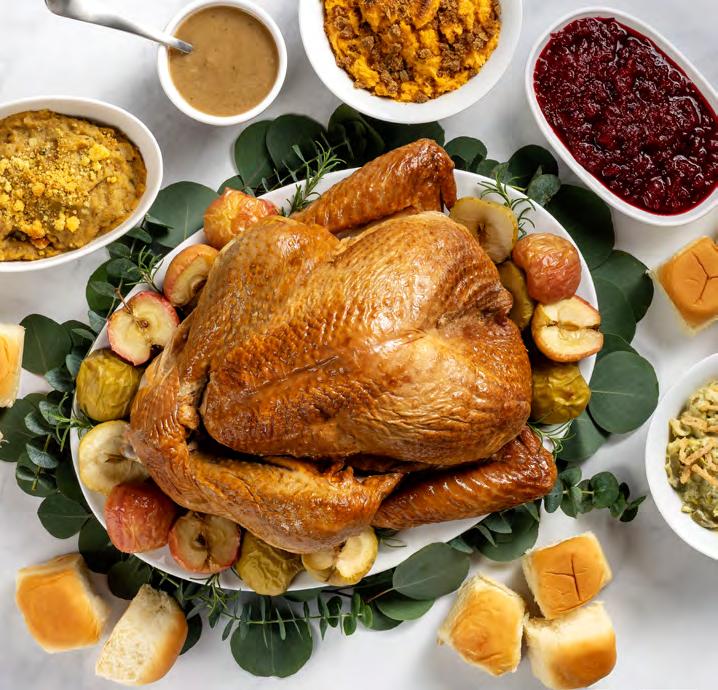
affects how the food you prepare tastes; it sets the stage for how the entire day will go.”
In other words, a relaxed host makes better-tasting food and sets the stage for a joyful gathering.
The first step is to pick your holiday style. A perfectly choreographed, balanced meal served flawlessly on sparkling china is tough to pull off without kitchen staff. Adjust your expectations.
One side of Amy’s family embraces a paper-plates, serve-yourself-from-the-poton-the-stove feast while the other enjoys a fine-china, multicourse, sit-down meal.
I’ve tried it both ways: A buffet with paper plates and warming trays is certainly easier and allows for folks to come and go — but there’s a warmth that comes with everyone sitting down together, saying grace and passing food family-style that I treasure.
Regardless of your style, to succeed you’ll need to embody seemingly disparate personalities: The careful planner and the go-with-the-flow hippy.
Here are tips from Amy and me for when to hold the reins and when to let go.
A month out, invite guests and give them a few days to RSVP. When that date passes, reach out to non-responders. A few days before the dinner, check in again with any undecideds. An accurate head count affects just about every aspect of the meal.
That said… If you’ve invited a big group, folks may bail; others may show up unannounced. Set aside a few extra chairs and place settings so you can squeeze them in. Then, smile and adopt a more-the-merrier attitude.
ARROW-CIRCLE-RIGHT FOR DRINKS: Before dinner, one or two cocktails or glasses of wine per person should be sufficient. For wine with dinner, two servings are about right, so if each 750ml bottle serves five, do that math. Batched cocktails, pitchers of tea and chilled water, and a tub of soft drinks and sparkling waters allow guests to help themselves.
ARROW-CIRCLE-RIGHT FOR THE FOOD: Here are general guidelines for amounts of food you’ll need:
Caret-Right Soup – 1 cup per person
Caret-Right Salad – 1 cup, lightly packed, per person
Caret-Right Turkey – 1½ pounds (or 6 to 8 ounces of a meat total) per person
Caret-Right Gravy – ⅓ cup per person
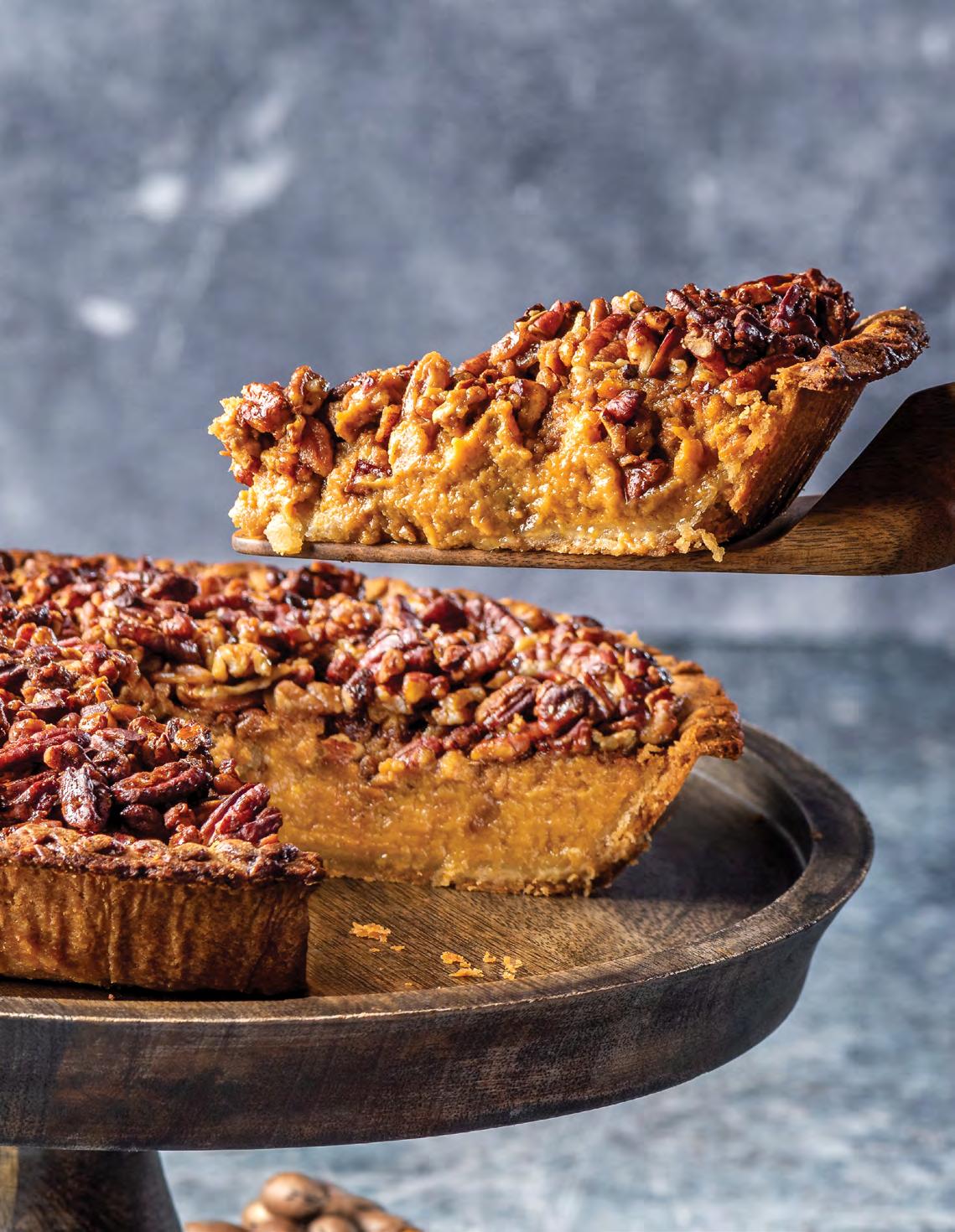
Caret-Right Stuffing, casseroles, vegetables or mashed potatoes – 1 cup total, if serving multiple sides, per person
Caret-Right Rolls – 2 to 3 per person
Caret-Right One 9-inch pie typically feeds 6 to 8
PECAN CRUNCH BOURBON SWEET POTATO PIE
mouse-pointer Visit www.rouses.com for this recipe and more of our holiday favorites!
2. EMBRACE MAKE-AHEAD DISHES AND POTLUCK OFFERINGS. Once she’s created her menu with complementary dishes, Amy works toward having very little cooking to do the day of the meal. Yes, the turkey or roast will need to go in the oven and the salad must be freshly tossed, but breads and rolls, casseroles, pies — even gravy — can be made ahead and frozen for up to three months. Amy’s mother-in-law makes five cornbread dressing casseroles at Thanksgiving and freezes three for Christmas. Amy herself found a brilliant make-ahead gravy recipe in The New York Times that uses roasted poultry legs or wings to create drippings so she can make and freeze her gravy.
Keep in mind, however, that frozen dishes will likely need at least two days to thaw in the refrigerator. (If you’re roasting a frozen turkey, it must be in the refrigerator for 24 hours for every four pounds of bird to thaw properly.) Amy stores space-stealing jars in an ice chest to make room in her refrigerator.
That said… Yes, you have a plan, but “graciously accept things that don’t match your menu, because this isn’t always about you,” Amy said. “If my friend from Brazil wants to bring black beans and rice because that’s what her family eats at the holidays, we graciously accept…. Then, there’s a story and greater sharing at the table.”
3. ASK FOR AND ACCEPT HELP. No, you do not have to make every dish from scratch — even if your granny did. Make use of grocers and caterers, but keep in mind it’s their busy time of year, so check deadlines. Order fresh turkeys as early as possible.
Guests inevitably will ask: “What can I bring?” Be prepared to answer with what you really need. “Assign them only what they’re capable of, what they can handle,” Amy said. That might be ice and soft drinks. If they’re prone to be no-shows or late-comers, suggest an extra bottle of wine or a pie.
That said… If someone bails at the last minute or you forget to order a side, don’t stress. Chances are you’ll have more than enough food.

dishes, utensils and chairs; kitchen tools, spices, canned goods and staples; to-gocontainers for leftovers. Does your oven (or perhaps your entire house) need a deep cleaning?
A week before, do your major grocery shopping to avoid crowds, and start cooking and freezing. In an ideal world, most of the messy peeling, slicing and chopping should be completed a couple of days before the meal, Amy said. “I try to not cook anything the day before. I’m getting in the spirit. I’m getting my head right. Tomorrow may be chaotic but that’s OK. We’re playing music, setting the mood.”
A couple of days before the meal, review your to-do list and mentally walk through your timing. When does the turkey go in the oven, so there’s enough time allowed for the bird to rest before carving?
The day before, pick up catered dishes. Finish last-minute cooking, set your table, including putting out serving bowls and utensils. Amy uses a roll of blue masking tape and a Sharpie to write which food goes in each bowl, so guests can more easily help her dish it all out on the big day. And before you go to bed the night before, don’t forget to run and empty the dishwasher, clear the counters and put out the trash.
prepared foods section and get the tastiest side dish left, or dress up a frozen option.
Too busy to cook ahead? Try to get the messiest work done: “If I know I have to cook something in the moment, those onions are chopped and measured into a little container,” she said. “I make little kits ready to be assembled.”
5. DON’T DESERT DESSERT. Relax and enjoy the entire meal. After dinner, let folks help you clear and refrigerate what’s essential to avoid spoilage. Scrape and stack dishes, but let the big cleanup wait so you can dig into pie with everyone else.
That said… If your mother-in-law loves to do dishes, let her. And keep this in mind: If it takes you a few days to get everything back into its proper place post-feast, that’s okay.
Finally, as Amy points out, if you throw a great party, “Sometimes, the biggest problem is getting them to leave. You need an exit strategy.” She recommends creating a tradition of ending the day with a trivia game. Then, when the time comes, she fills everyone’s to-go boxes with leftovers.
4. STAY ORGANIZED. Two weeks before the meal, see if you have what you need: table linens, dinnerware, serving
That said… If you don’t have everything you need, don’t break the bank buying it. Borrow platters, tables and chairs, convection burners or ice chests. Forgot to order something? Swing by the grocery’s
“Once they have their to-go box, they’re not going to sit there and hold it,” she said, adding, with a laugh, “give them all a napkin and a to-go box and second-line them out the door.”






by Poppy Tooker

Dâc biêt” personifies the very essence of Chef Nini Nguyen. Translated from Vietnamese as “something extra,” dâc biêt is Vietnamese American slang these days referring to someone or something as distinguished or special. “If I had to find a word that describes me, my cooking style, my philosophy and way of life, dâc biêt sums it up,” Nyguyen said with a grin. When deciding on a name for her new book, Dâc Biêt seemed the natural choice.
This very personal book is a long time coming. After two seasons on Top Chef, Nguyen received lots of cookbook offers. “But if I’m going to put something out into the world, I want it to really mean something,” she reflected. Her cookbook Dâc Biêt does just that.
Growing up in New Orleans East surrounded by a close and loving family, with one grandmother from North Vietnam and the other from South Vietnam who “often cooked the same dishes, but the seasoning and finishing touches were so different, I formed my own preferences,” she said. “which all made sense when I visited Vietnam for the first time. That was an awakening.”
Nguyen’s maternal grandmother had enormous influence on her early life. She fled Vietnam in 1975, coming to New Orleans with her husband and their combined families, together totaling 11 children. When her husband died just four years later, his widow went to work as an oyster shucker at P & J Oyster Company to support the family. “The scent of oysters still reminds me of my grandmother,” Nguyen said. “She left home for work every morning at 3am, bucket, boots and oyster knife in hand. ‘You see how hard I work?’ she asked Nguyen. “You need to go to school so you don’t struggle like this.”
That promise stuck and Nguyen graduated from LSU’s business school, but restaurant jobs during college ignited a passion that could not be denied. After
stints at New Orleans’ Sucré and Coquette, the budding pastry chef struck out for New York City, where she was hired immediately at Michelin-starred Eleven Madison Park.
Her star ascended rapidly and, by 2016, Nguyen had an opportunity to open her own restaurant in the trendy Williamsburg neighborhood in Brooklyn, but a call from New Orleans changed everything. Her little brother Bobby had been diagnosed with stage IV stomach cancer. At the age of 27, he was given only a few months to live. At the same time, Top Chef had offered her a spot on their next season. Bobby urged her to go, but Nguyen refused to leave his side, cooking bowl after bowl of rice porridge with ginger and chicken. “I learned to make it from my dad’s mom, writing down exactly how she did it. It’s like our chicken soup, real comfort food. It was the only thing he wanted to eat. I promised Bobby if Top Chef called again, I’d go,” she said.
After Bobby’s death, Nguyen returned to New York and, while she was teaching at Cook Space, a cooking school in Brooklyn, Top Chef called again. Nguyen didn’t win but was invited back the following year for the All-Star season. It aired just as the COVID pandemic happened, and she pivoted to teaching cooking classes online.
This is when her “ding ding!” moment occurred. “I never thought Vietnamese people would take my classes because I thought they would have learned the food from their own families,” Nguyen said. Messages sent after class thanking her for connecting students with their heritage opened her eyes. These Vietnamese Americans had never been taught their own recipes due to language barriers or because of the push to assimilate. “I realized how lucky I was to have my family. Because of all they had taught me, I could be the door to our culture for others,” which is how Dâc Biêt came to be.”
understand meat loaf and mashed potatoes served together with their similar textures. “We avoid ‘yan’ or boredom of the mouth by choosing from different plates full of salty or sweet bites, crunchy or soft textures, so your palate is never fatigued. It makes things more crave-able,” she explained.
The significance of rice is poignantly illustrated in the chapter, “Have You Eaten Rice Yet? / An Com Chua.” For many Asian families, these words are meant to apologize, diffuse a tense situation or convey love. Nguyen shares the memory of her grandmother gently waking her, asking “An com chua?” Nguyen treasures that time, sitting alone with her grandmother in the middle of the night, sharing a bowl of broth and veggies over rice at the kitchen table.
With chapters on drinking, snacks, sauces, noodles, pickles, breads and pastries, Dâc Biet covers all bases. Creole and Cajun influences also integral to Nguyen’s identity are evident in her Southeast Asian Jambalaya, Viet Cajun Seafood Boil and dueling recipes for New Orleans Style Beignets vs. Vietnamese Style Beignets.
Between the pages, Chef Nguyen reveals all her personal cooking tips and secrets to “Make It Dâc Biêt.” Whether you’re a newcomer to Vietnamese food or on a search for your own heritage, Nini Nguyen’s Dâc Biêt truly delivers something extraspecial.

Unlike in other English Vietnamese cookbooks, Nguyen insisted all the dishes in hers bear their original names. “I wanted to depict the way our tables look and the way we eat,” she said. “Even the styling of the book is very reminiscent of what you would see at my grandmother’s house on a Tuesday night.” Her grandmother could never
Bánh Bò Nướng
Serves 6-8
The word “nướng” means “grilled” or “roasted,” even though this sweet and chewy cake is always steamed or baked. I like baking it because it develops a brown crust on the outside that really causes the bright-green, pandan-flavored inside to pop. But my grandma makes really cute steamed mini versions that are dyed all sorts of pastel colors. The baking powder in the recipe creates air bubbles in the batter, and gives the cake a dramatic honeycomb texture that’s probably contributed to its current popularity. This cake can be a little tricky to make though the steps are very simple. Just make sure you follow the steps and don’t over-whip the eggs.
One 14-ounce can coconut milk
200 grams sugar
1 teaspoon kosher salt
2 teaspoons pandan extract or paste
6 large eggs
320 grams tapioca starch
38 grams rice flour
1 tablespoon double-acting baking powder
2 tablespoons coconut oil
1. Preheat the oven to 350°F, and put a cake pan or bundt pan into the oven to make sure it gets really hot.
2. In a small pot set over medium heat, combine the coconut milk, sugar, and salt. Bring to a simmer and cook until the sugar and salt dissolve.
3. Add in the pandan paste and the eggs. Break up the yolks without whisking them. Whipping too

much air into the egg will cause the cake to collapse later.
4. Sift the tapioca starch, rice flour, and baking powder right into the egg mixture and whisk carefully, being sure not to add any air into the cake. The batter will be lumpy.
5. Set a strainer over a bowl, and pour the batter through the strainer. Use a spoon to work any clumps through the strainer.
6. Add the coconut oil to the batter, and mix to combine. Pour the batter into the hot cake pan, and bake for 40 to 45 minutes or until a toothpick comes out clean.
7. Once the cake is cooked, leave the cake inside of the oven and let it cool off slowly by opening the door. This prevents it from deflating too much. Let it cool and enjoy.
From Dâc Biêt © 2024 by Nini Nguyen. Excerpted by permission of
ARROW-CIRCLE-RIGHT What restaurants matter in New Orleans right now? How has the city’s dining scene changed since the pandemic? Who are the chefs shaping what we love to eat? These are the questions New Orleans food and travel writer Beth D’Addono considered when writing her new book, City Eats: New Orleans (Cider Mill Press/ HarperCollins, $22.99.) “I have the best job in the world,” said D’Addono, who covers the New Orleans restaurant scene for outlets like Eater, Gambit and The Local Palate, and contributes to Rouses Magazine. “There has been a big shift since the pandemic closed our hospitality industry down. Sadly, we lost a lot of restaurants. But many chefs also found their voices, opening restaurants and taking long overdue seats at the table. With this book, I wanted to take a deeper dive into what we’re eating right now, what will always matter and what’s new.” Available online on Amazon, and at bookstores and specialty shops around New Orleans.

ARROW-CIRCLE-RIGHT My great-grandmother taught me how to love people through food. That knowledge, that ability, is my greatest inheritance. Mamman, as I knew her, loved to cook but most of all, loved to feed her family. Every Sunday was a special event at Mamman’s table. White linen and crystal, gleaming sterling silver flatware...Mamman didn’t cut any corners. The midday dinner proceeded at a leisurely pace with those she loved gathered around. The food was not opulent, just delicious: Shrimp salad, oyster rice dressing and peas in a roux all made regular appearances along with her dark, rich chicken stew and dumplings. Unlike the pallid affair most associate with the dish, Mamman’s chicken stew started with a dark roux seasoned with celery, bell pepper and onions served over steaming rice.

Loulie, our housekeeper, loved me with food too. For the first 10 years of my life, she cooked every meal we ate at home. The freezer was filled with stuffed peppers and other goodies stashed for weekends when she wasn’t there. But when I was 10 years old, all that love went away.
Over the course of a few short months, my great-grandmother died suddenly and Loulie retired. Suddenly, my mother (who hated cooking) had to feed her family of four, and it did not go well. Some people say you can taste the hand that stirred the pot. I know from personal experience: If the cook abhors the task, you can taste it. I grieved not only for my Mamman and Loulie, but also for their delicious food.
Slowly, I began to experiment. First with simple things like scrambled eggs and grilled cheese sandwiches; once I found my way around the kitchen, I felt right at home.
I developed an interest in the weekly food section, and Times-Picayune writer Miriam Guidroz became my first teacher. On WYES-TV Julia Child was teaching America how to cook, and I was an avid pupil.
My mother was thrilled. By the time I was in 7th grade, I rushed home from Ursuline Academy every afternoon eager to cook dinner. A supermarket two blocks away provided any needed ingredients with some specialty items coming from Radosta’s Italian grocery on Carrollton Avenue. Poring over The Joy of Cooking, I experimented to my heart’s content.
There were some failures. A Mother’s Day lemon pound cake stands out in memory as one of the worst. The recipe called for a cup of oil, but no one explained to me I couldn’t use oil leftover from a fish fry. I remember my grandmother Nana eating her way through that abominable slice of cake, insisting “Really, Poppy! It’s good!”
Away at college, I became the cook at CalArts’ dorm restaurant, Mom’s Café. Given total freedom to cook whatever I wanted, I taught fellow students to love red beans and


FRANK DAVIS COOKS NATURALLY N’AWLINS
ARROW-CIRCLE-RIGHT Frank Davis’ Fishin’ Game Report made you want to drop everything and go fishing. His cooking segments left you hungry, and his Naturally N’Awlins lifestyle features — celebrating local traditions like sno-balls, oyster shuckers and Mr. Okra — showed you what it truly means to love New Orleans.
rice, jambalaya and other Louisiana specialties. The best lesson I learned at CalArts was that cooking gave me the same thrill as theater and I instinctively realized food would be a safer and happier path for me.
My education continued in restaurant kitchens from California to Connecticut. Then, back in New Orleans, my life took another dramatic turn when I became a teaching assistant at Lee Barnes Cooking School. Lee’s motto was “Love To Eat? Learn To Cook!” After a few months she convinced me I could become a cooking teacher myself. Lee introduced me to Madeline Kamman, author of The Making of a Cook and a renowned teacher herself. I enrolled in her professional course spending six months in a New Hampshire inn, studying and cooking alongside five other students, six days a week. I graduated with a chef’s diploma and — most important to me — a cooking teacher certificate.
For many years I had the opportunity to share the knowledge of New Orleans’ food with an unending stream of tourists eager to learn how to make a roux. Believing that knowing the true origins of a dish makes it tastes better, I explored food history, learning not just how it’s done, but why we’ve always done it that way. Our historic foodways became my primal focus.
In 1998 I was introduced to the Slow Food movement, an international organization ready to help me save our endangered foods. I quickly focused on rescuing traditional New Orleans foods like Creole cream cheese and rice calas from extinction, urging people to “Eat It to Save It.” Those words came straight from Mamman. When requesting I finish my meal, instead of saying, “Clean your plate,” she would implore, “Poppy, eat it to save it.”
Given the opportunity to write on these favorite topics, I was able to further spread the word. The foreword I penned for a revision of Madame Bégué’s Recipes of Old New Orleans Creole Cookery led to my Tujague’s and Pascal’s Manale cookbooks. Then, 14 years ago I created Louisiana Eats!, WWNO’s first locally produced radio show. Heard on NPR affiliates statewide and podcast internationally, that platform has allowed me to celebrate our food and our food heroes in ways I could never have imagined.
When I produce my Louisiana Eats! weekly radio show, I always make sure to smile into the microphone. Imagining a listener experiencing a rough day, I hope they hear my smile and catch a bit of contagious happiness. With my smile, I send love across the airwaves, just as surely as the love that stirred my great-grandmother’s pot. – Poppy Tooker
At our house in New Orleans, there was always a Frank Davis cookbook on the kitchen counter. Almost everyone I know owns the full collection of his cookbooks. They’re all iconic: The Frank Davis Seafood Notebook; Frank Davis Cooks Cajun, Creole, and Crescent City; and, of course, Frank Davis Makes Good Groceries! Frank didn’t attend culinary school, nor did he ever pretend to cook gourmet meals. But he understood New Orleans cuisine better than just about anyone.
I have a large collection of cookbooks, but I find myself returning to Frank Davis’ again and again. Right now, Frank Davis Cooks Naturally N’Awlins is open on my counter, flipped to his Cajun Jambalaya recipe. I can cook jambalaya in my sleep — most months, I make it by the gallon. But every now and then, I revisit the “bible” to remind myself how Frank did it.
– Chef Chad Kirtland
CHICKEN’S KITCHEN, GRETNA, LA
ARROW-CIRCLE-RIGHT Chef Marlon “Chicken” Williams’ takeout lunch spot has customers lining up around the block for his Southern staples. Nominated in the Best Chef: South category in the 2024 James Beard Awards, Williams serves rotating daily specials, including oxtails and other crowdpleasers, Monday through “Fryday.”




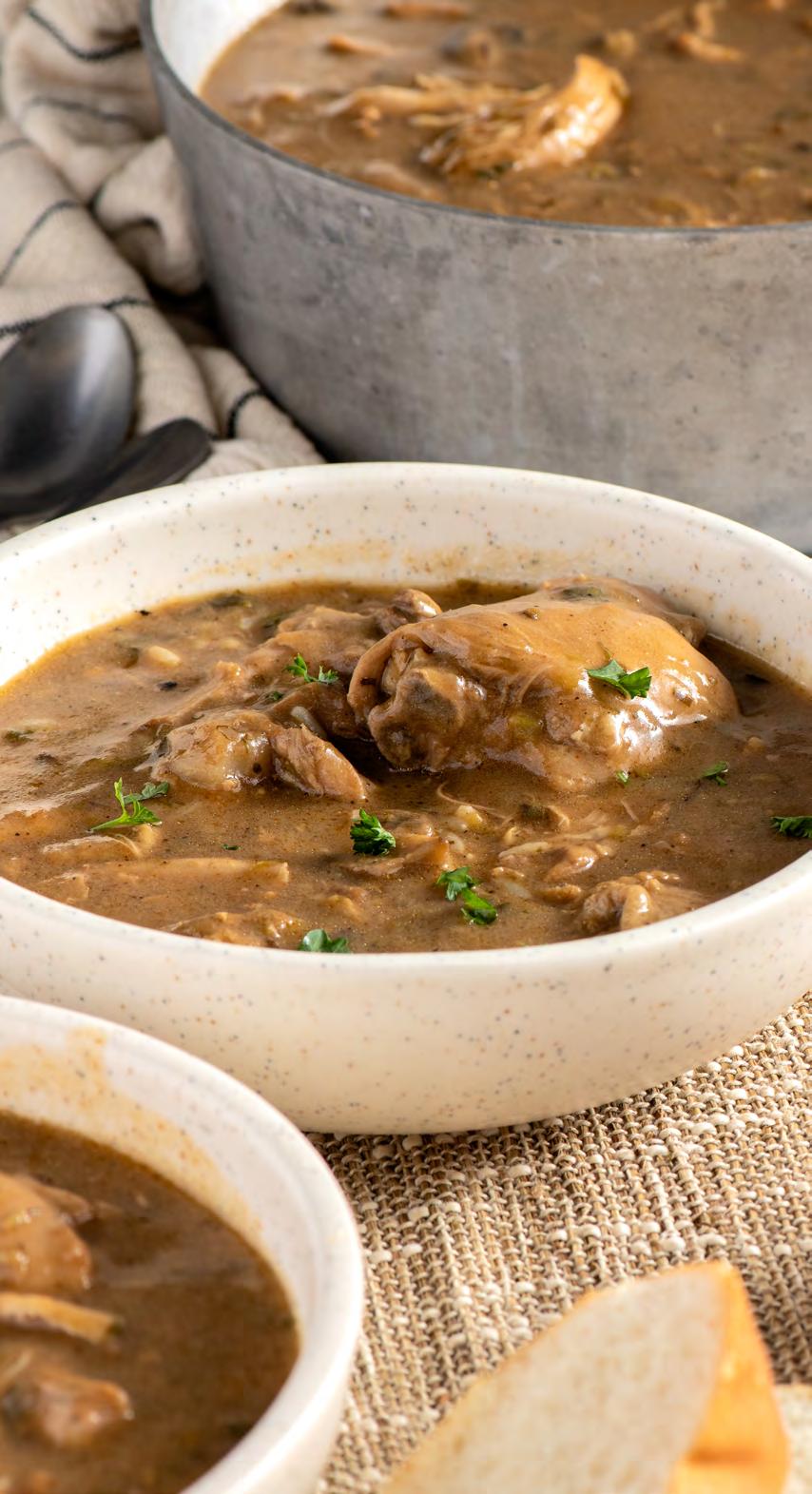
ARROW-CIRCLE-RIGHT Chicken stew is a classic Cajun one-pot dish made by slowly braising bone-in chicken, usually a whole cutup chicken, in a rich, rouxbased gravy. This process creates a thick, savory sauce that coats the chicken, which is traditionally served over rice. The Cajun version of chicken fricassee is similar but begins by smothering or pan-frying the chicken in butter or oil before slowly simmering it in the sauce to make it tender. Both dishes start with a dark roux made from flour and oil or fat cooked until it reaches a deep brown color — a hallmark of many Cajun recipes. Compared to the lighter French version, the Cajun fricassee is more rustic and earthy.
ARROW-CIRCLE-RIGHT Smothering is a classic cooking technique in both Cajun and Creole cuisines that involves cooking something down slowly. Pork, seven steak, meatballs or vegetables are cooked in a covered pan with a moderate amount of liquid, in a method similar to stovetop braising. Smothered dishes are often served over rice, creating a delicious combination of tender meat and rich, flavorful gravy, known simply as “rice and gravy.”
TOTAL TIME: 1 hour, 30 minutes to 1 hour, 45 minutes
SERVES: 8
STORAGE: Refrigerate for 3-4 days
MAKE AHEAD: If you’re using homemade chicken broth, you can make it ahead and store it in the refrigerator for up to 3 days, or freeze it for longer storage.
WHAT YOU WILL NEED:
1½ cups all-purpose flour
1 cup canola or vegetable oil
1 medium onion, chopped
1 medium green bell pepper, chopped
1 celery rib, chopped
1 cup white button mushrooms, wiped clean and sliced
6 cups chicken broth
5 pounds bone-in chicken thighs
1 bay leaf
Creole seasoning, to taste
Hot rice, for serving
HOW TO PREP:
In a 4- to 5-quart heavy pot, heat the oil over moderately high heat until hot but not smoking. Stir in the flour with a flat metal or wooden spatula and cook, scraping back and forth constantly (not
stirring), until the roux reaches the color of milk chocolate, about 10 to 20 minutes. Add the chopped onion, bell pepper and celery to the roux. Cook, scraping occasionally, until the onion is softened, about 8 minutes. Stir in the sliced mushrooms and combine well.
Gradually add the chicken broth, stirring occasionally to incorporate it into the roux. Bring the mixture to a boil. Once boiling, add the chicken thighs and the bay leaf to the pot. Reduce the heat to a simmer and cook, partially covered, for about 1 hour, or until the chicken is cooked through and the gravy has thickened. Remove the bay leaf and discard it. Stir in Creole seasoning to taste. Serve the stewed chicken hot over rice.
TOTAL TIME: 30 minutes SERVES: 6
MAKE AHEAD: You can prepare the pasta up to 1 day in advance and refrigerate it. Add the olive salad and olive oil just before serving.
STORAGE: Refrigerate in an airtight container for up to 2 days.

WHAT YOU WILL NEED:
1 pound fusilli or rotini pasta, or other small pasta
½ pound provolone or mozzarella cheese, cut in thin slices
½ pound salami, cut in thin slices
1 (32-ounce) jar Rouses Italian Olive Salad, drained and oil reserved.
HOW TO PREP:
Bring a large pot of salted water to a boil over high heat. Add the pasta and cook according to package directions. Drain and rinse well under cold water; drain again and transfer to a large serving bowl. Add the cheeses and salami. (If making ahead, at this point, cover and refrigerate without adding the olive salad and olive oil.) Add the olive salad and toss to combine. Add reserved olive oil to taste. Serve right away at room temperature, or refrigerate until ready to serve.

TOTAL TIME: 35-45 minutes
(depending on how tender you want the cabbage)
SERVES: 6-8
STORAGE: Refrigerate for 3-4 days
MAKE IT HEARTIER: Slice about 1 pound of smoked sausage into rounds or half-moons. Brown the sausage along with the ham in the olive oil, then follow the rest of the recipe as written.
WHAT YOU WILL NEED:
1 head fresh green cabbage, washed, cored and roughly chopped
1 large yellow onion, diced
1 pound diced smoked ham
2 tablespoons olive oil
2 tablespoons water
Salt and pepper to taste
HOW TO PREP:
Heat the olive oil in a large pot or skillet over medium heat. Add the diced smoked ham and cook until lightly browned, about 5 minutes.
Add the diced onion to the pot and sauté until tender and translucent, about 5-7 minutes. Stir in the chopped cabbage and add the 2 tablespoons of water. Cover the pot with a lid and cook over medium heat for about 15 minutes.
Remove the lid, stir the cabbage, and season with salt and pepper to taste. Cover again, reduce the heat to low, and simmer for an additional 10-20 minutes until the cabbage is tender, depending on your desired texture.
Once the cabbage is tender, remove from heat and serve warm.
TOTAL TIME: 1 hour, 35 minutes to 1 hour, 40 minutes
SERVES: 12
STORAGE: Refrigerate for 3 to 4 days; when reheating, heat gently over medium heat on the stovetop until warmed through.
WHAT YOU WILL NEED:
1 cup vegetable oil
¾ cup all-purpose flour
6 celery stalks, diced
2 large onions, diced
2 bell peppers, diced
6 garlic cloves, minced
1 pound andouille sausage, sliced ½-inch thick
4 quarts seafood stock
1 pound wild-caught Gulf shrimp, peeled and deveined
1 pound jumbo lump Gulf crabmeat, picked over for shells
4 Gulf gumbo crabs, halved
1 pint shucked Gulf oysters and their oyster liquor
½ cup chopped parsley
½ cup diced green onion
Salt and pepper to taste
6 cups cooked white rice or potato salad, for serving
In a large, heavy-bottomed pot or Dutch oven, warm the vegetable oil over low heat. Gradually add the flour, stirring constantly, and cook for about 30 minutes until you achieve a medium-brown roux.
Add the diced celery, onion, bell pepper, garlic, salt and pepper to the roux. Continue cooking and stirring for about 15 minutes, or until the vegetables have wilted.
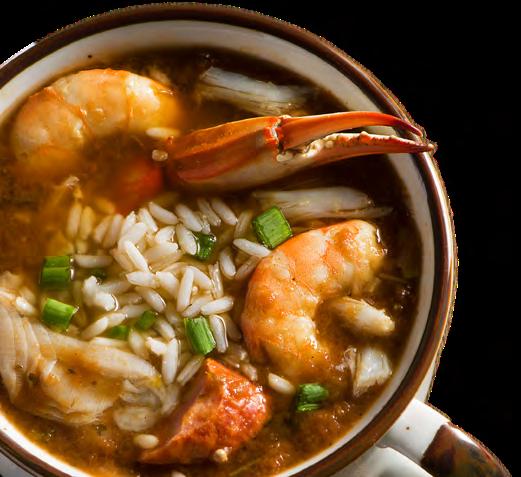
In a separate skillet, brown the sliced andouille sausage for about 5 minutes. Set it aside.
Slowly add the seafood stock to the roux mixture, one ladleful at a time, stirring after each addition. Bring the mixture to a boil, then reduce to a simmer and cook for 30 minutes, stirring occasionally. After simmering, add the browned andouille sausage, shrimp, crabmeat, halved gumbo crabs and shucked
oysters (including their oyster liquor). Return the gumbo to a boil and cook for an additional 5 minutes.
Stir in the chopped parsley and diced green onion. Taste and season with additional salt and pepper as needed.
Ladle the seafood gumbo over cooked white rice or serve it alongside Rouses Potato Salad.
ROAST, RICE & GRAVY
TOTAL TIME: 1 hour, 20 minutes to 1 hour, 40 minutes
SERVES: 8
STORAGE: Refrigerate for 3-4 days; when reheating, you can warm it gently on the stovetop, in the oven at a low temperature, or in the microwave.
WHAT YOU WILL NEED:
1 chuck roast, 3-4 pounds
1 tablespoon Creole or Cajun seasoning mix
1 tablespoon all-purpose flour
3 tablespoons vegetable oil
1 large onion, coarsely chopped
6 garlic cloves, peeled
1-2 cups (or more as needed) beef broth or stock
1 tablespoon chopped parsley
2 bay leaves
Hot white rice, for serving
HOW TO PREP:
Preheat the oven to 325°F.
Heat a large, heavy pot or Dutch oven over medium-high heat. Generously season the chuck roast with Creole or Cajun seasoning and dust it evenly with the flour. Coat the bottom of the pot with the vegetable oil. When vegetable oil is hot but not smoking,sear the roast on all sides until evenly browned, about 4 minutes per side. Transfer the roast to a platter.
In the same pot, add the coarsely chopped onion and peeled garlic cloves and a small amount of cold water to break up the drippings. Sauté, stirring frequently and scraping up the browned bits from the bottom of the pot, until the onions and garlic are soft, about 5-7 minutes. Return the roast to the pot and add
enough beef broth or stock to cover the meat. Stir in the bay leaves and chopped parsley. Cover the pot with a lid and transfer it to the oven.
Cook the roast in the oven for about 45 minutes to 1 hour, or until the meat is fork tender.
Remove the pot from the oven and discard the bay leaves. Let the roast rest for about 15 minutes before slicing. Adjust seasoning as needed.
Serve the pot roast and gravy over rice.
TOTAL TIME: 1 hour
SERVES: 8-10
STORAGE: Refrigerate for 3 to 4 days; when reheating, do so gently over medium heat on the stovetop to avoid breaking the cream and overcooking the crab.
MAKE AHEAD: If you’ve removed the kernels from the cobs, you can store the fresh corn kernels in an airtight container or resealable plastic bag in the refrigerator for up to 3-5 days. You can make the seafood stock with the corn cobs and vegetable scraps up to 3 days in advance and store it in the refrigerator. This step saves significant time on the day of cooking.
WHAT YOU WILL NEED:
3 cups whole fresh corn, removed from cobs
(save cobs and add them to seafood stock)
1 pound jumbo Gulf lump crabmeat
1 cup salted butter
1 cup white onion, diced
1 cup celery, diced
½ cup red bell pepper, diced
¼ cup garlic, minced
1 cup all-purpose flour
2½ quarts seafood stock (simmered with corn cobs, onion, celery, green onion and parsley for 30 minutes)
1 pint heavy whipping cream
½ cup green onion, thinly sliced ½ cup parsley, chopped
Salt and white pepper, to taste
Simmer 2½ quarts of seafood stock with the reserved corn cobs, onion, celery scraps, green onion and parsley for 30 minutes. Strain through a fine mesh strainer and set aside. In a large pot, melt the butter over medium heat. Add the corn, diced onion, celery, red bell pepper and minced garlic. Sauté until the vegetables are tender, about 5-7 minutes.
Gradually whisk the flour into the sautéed vegetables to form a white roux. Stir continuously, but do not let the roux brown. Slowly add the strained seafood stock to the roux, stirring constantly to avoid
lumps. Reduce the heat to low and let the bisque simmer for 30 minutes. Stir in the heavy whipping cream, green onion and parsley. Cook for another 3 minutes, allowing the flavors to combine. Gently fold in the crabmeat, being careful not to break up the large chunks. Cook for an additional 2-3 minutes until heated through. Season with salt and white pepper to taste. Serve hot with crusty bread or over rice if desired.
Optional: Add 1 cup fried chopped bacon or pancetta to stuffing mixture. The stuffed artichokes can be prepared in advance and reheated before serving. Leftover stuffing keeps for 2 weeks in the refrigerator and longer in the freezer. The stuffing is so delicious, it can be cooked on its own and used to enhance almost any meal.
TOTAL TIME: 1 hour, 30 minuteto 2 hours SERVES: 6
MAKE AHEAD: Prepare the stuffing up to 2 days in advance and refrigerate in an airtight container. Stuff the artichokes up to 1 day ahead; cover tightly and chill. Bring to room temperature before steaming for best results.
STORAGE: Refrigerate for up to 2-3 days in an airtight container.

WHAT YOU WILL NEED:
6 large artichokes
10 cups Italian seasoned bread crumbs
1½ cups Parmigiano-Reggiano cheese
1 cup scallions, chopped
½ cup parsley, chopped
12 garlic cloves, finely minced
2 tablespoons salt
1 tablespoon freshly ground black pepper
1 tablespoon cayenne pepper
2½ to 3 cups olive oil
6 lemon slices
1 dash lemon juice or white vinegar (optional)
6 lemons
Using scissors, trim off the pointed ends of each artichoke and rub a lemon on the cut ends to prevent browning. Slice off the stem ends of each artichoke so they stand up straight in the pan.
Combine all the ingredients (except the artichokes, lemon slices, dash lemon juice or white vinegar, and olive oil) in a large
bowl. Add 2 cups of the olive oil and mix well until mixture has the texture of stuffing. Spread the leaves of each artichoke open without breaking them, and tuck as much stuffing as possible down into each leaf, tapping the artichoke gently to let any loose stuffing fall off.
Stand the artichokes in a casserole that is stovetop safe or a metal roasting pan just large enough to hold them in a single layer. Add water to a depth of 1½ inches and pour a generous amount of olive oil over each artichoke, letting it seep in. (Optional: You can add a dash of lemon juice or white vinegar to the water to help the artichokes retain their fresh green hue.) Juice a fresh lemon over each artichoke, and top each with a slice of lemon. Bring the water to a boil, then reduce heat to low and steam the artichokes, covered, checking occasionally to see if it’s necessary to add more water, for 45
minutes to an hour (possibly more), or until the leaves pull away easily and the pith — the tender, edible flesh at the base of each leaf — is soft. Serve hot or warm.
TOTAL TIME: Around 1 hour, 20-25 minutes
SERVES: 10-12
STORAGE: Refrigerate leftovers for up to 3 days; reheat in a 350°F oven, or microwave individual portions. MAKE AHEAD: You can core and chop the cabbage ahead of time and store it in an airtight container or resealable bag in the refrigerator for up to 1-2 days.
WHAT YOU WILL NEED:
2 tablespoons canola oil
1 pound Rouses Green Onion Sausage, removed from casing
1 pound lean ground beef

1 large white onion, chopped
1 medium green bell pepper, chopped
4 cloves garlic, peeled and chopped
2 cans RO-TEL Diced Tomatoes & Green Chilies (original)
1 tablespoon Rouses Creole Seasoning
1 tablespoon Cajun Power Garlic Sauce
1 tablespoon DeLallo Hot Pepper Garlic Sauce
2 teaspoons Kitchen Bouquet
1 large green cabbage, cored and chopped
1 cup uncooked rice
1 cup water
HOW TO PREP:
Preheat the oven to 350°F.
Heat the canola oil in a Dutch oven over medium-high heat. Add the green onion sausage and ground beef, and cook until browned. Remove the meats from the pan and set them aside on a plate lined with paper towels to absorb the excess grease. In the same Dutch oven, add the chopped onion and bell pepper. Sauté until browned, about 5-7 minutes. Then add the garlic and cook for an additional 2 minutes. Return the cooked sausage and ground beef to the Dutch oven with the sautéed vegetables. Stir in the RO-TEL Diced Tomatoes & Green Chilies, Rouses Creole Seasoning, Cajun Power Garlic Sauce, DeLallo Hot Pepper Garlic Sauce and Kitchen Bouquet. Cook for about 5 minutes to let the flavors meld and slightly reduce the sauce. Stir in the chopped cabbage, uncooked rice, and 1 cup of water. Mix everything together until well combined.
Cover the Dutch oven with its lid and place it in the preheated oven. Bake for 1 hour.
After 1 hour, remove the Dutch oven from the oven and give the casserole a good stir. Ensure the rice is fully cooked. If necessary, return to the oven for a few more minutes until the rice is tender. Once done, remove from the oven and allow the casserole to cool slightly before serving.
TOTAL TIME: 35-40 minutes, depending on how many batches you make
MAKES: 18 to 24 cookies
STORAGE: Store baked cookies in an airtight container for up to 5 days.
3 cups all-purpose flour
1 teaspoon baking powder
1 teaspoon baking soda
1 teaspoon salt
1½ cups brown sugar
1 cup unsalted butter, softened
½ cup sugar
2 large eggs

1 tablespoon vanilla extract
1 cup shredded coconut
¾ cup chopped macadamia nuts
1 (12-ounce) bag semi-sweet chocolate chips
Preheat oven to 350°F. Line a baking sheet with parchment paper and set aside. In a bowl, stir together the flour, baking powder, baking soda and salt.
In the bowl of an electric mixer fitted with a paddle attachment, beat the sugars and butter together until light and fluffy, about 5 minutes. Beat in each egg, one at a time. Beat in the vanilla extract. Add the dry ingredients from the first bowl, and beat on low speed until just combined, scraping the bottom of the bowl if needed. Stir in the coconut and macadamia nuts. Stir in the chocolate chips.
Scoop out 1½-inch sized balls of dough and place them on the parchment paper about 2 inches apart. Place baking sheet in preheated oven and bake for 16 to 18 minutes, or until the cookies are just golden on the edges. Remove from oven and let the cookies cool for 10 minutes on the baking sheet before transferring them to a cooling rack. They should be chewy with crispy edges.
ARROW-CIRCLE-RIGHT Regina’s Kitchen is always bustling thanks to a loyal crowd that can’t get enough of the sandwiches, salads and soups. Located near Brookley Field, this lunch-only spot has been a local favorite for years. Many of the sandwiches are named after Regina’s family and friends, a tradition carried on by Regina Florey, who follows in the footsteps of her mother, Mary Ann Nelson, the original owner of Mary Ann’s Deli.
PUNJABI DHABA, HAMMOND AND KENNER, LA
ARROW-CIRCLE-RIGHT Tucked inside a gas station off I-12 in Hammond, Punjabi Dhaba serves up authentic Indian flavors like tikka masala, vegetable pakoras and tandoori chicken. The restaurant, named after the roadside eateries in India, became a favorite stop. In December 2022, a second, more upscale location opened in Kenner, offering both a buffet and a full dinner menu with signature dishes like lamb vindaloo and chicken 65.

Baker’s Note: At the store we use our exclusive Rouses Almond Cake, but you can get a similar taste with white cake mix and a few drops of almond extract. While we sell a three-layer version of the Berry Gentilly Cake, this two-layer version is easier to make at home.
TOTAL TIME: 3½ hours (including cooling and refrigeration)
SERVES: 12-14
MAKE AHEAD: You can bake the cake layers up to 1-2 days in advance. Once cooled, wrap them tightly in plastic wrap and store at room temperature. You can make the icing up to a day ahead. Store it in an airtight container in the refrigerator. The syrup can be made a few days in advance. Store it in a jar or airtight container in the refrigerator. You may need to stir it before using, but it will stay good for about a week.
1 (15.25-16.25 ounce) white cake mix
¼ teaspoon almond extract
Splash of water
Eggs, oil and other ingredients as indicated on cake mix box
Gentilly icing (recipe follows)
Orange simple syrup (recipe follows)
Apricot glaze (recipe follows)
¼ cup sliced strawberries
¼ cup raspberries
¼ cup blueberries
¼ cup blackberries
Whole strawberries, raspberries, blueberries and blackberries for garnish
Gentilly Icing:
8-ounce container cream cheese, at room temperature
8-ounce container mascarpone cream cheese, at room temperature
1 cup confectioners’ sugar
2 cups heavy whipping cream
1 teaspoon almond extract
Orange Simple Syrup:
¼ cup hot water
¼ cup sugar
2 teaspoons orange extract
Apricot Glaze:
3 tablespoons Rouses Apricot Jam
Splash of water
HOW TO PREP:
Prepare cake according to package directions. Add almond extract with splash of water. Bake according to package directions in 2 (9-inch) cake pans. Meanwhile, prepare icing, syrup and glaze.
Icing: In the bowl of an electric mixer fitted with a paddle attachment, mix
the cream cheese and mascarpone together. Reduce the speed to low, add the confectioners’ sugar and blend until fully mixed, increasing the speed to medium as the sugar is incorporated. Reduce the speed to low, add the whipping cream and almond extract, and whip, increasing the speed to mediumhigh as the cream is incorporated. Whip until stiff peaks form. Set aside.
Syrup: In a small bowl, combine water, sugar and orange extract until completely mixed. Set aside.
Glaze: Heat jam in a small microwave-safe bowl or ramekin. Stir in water a few drops at a time to make a thin glaze. Set aside.
To assemble: Transfer one cool cake layer to a plate or cake stand. Drizzle with orange syrup. Cover with a thick layer of icing, and evenly distribute sliced strawberries and other berries, reserving whole fruits for garnish. Place the second cake layer on top of the first. Drizzle with orange syrup. Pipe or spread remaining icing and garnish with whole strawberries, raspberries and blueberries. Use a brush to lightly coat the berries with apricot glaze. Let dry. Refrigerate cake until ready to serve.


LOVE THE CAKE?
mouse-pointer Visit www. rouses.com for our Gentilly Cream Pancakes recipe!




















































The wine lexicon is thousands of words long, but there are a few common terms you might hear when talking to wine people. Here are some typical words and phrases you should know.
ARROW-CIRCLE-RIGHT
The next time you pour a glass of wine, take a moment to think about its aroma (its “nose”) emerging from the glass. Wine is subtle, but there are a few easy tasting notes you’ll usually be able to find. A white wine will oftentimes have notes of lemon or green apple. A red wine will probably have a bit of cherry. There are hundreds of other possible tasting notes, though, ranging from floral to barnyard. If someone calls a wine “fruit forward,” its tasting notes are predominantly fruity.
ARROW-CIRCLE-RIGHT
When someone talks about a wine’s body, they’re talking about several things coming together at once. There’s its alcohol level, which you can feel as a burning in the back of your mouth when you exhale — a “dragon’s breath” kind of sensation. (You can also just read the wine label — almost every wine lists its alcohol percentage right on the bottle.) Generally speaking, “full-bodied” wine likely has higher levels of alcohol and tannins. Other factors also come into play, such as the wine’s acidity. A dry, lower-alcohol wine with higher acidity is likely “light-bodied.” Pinot noir and Beaujolais are common light-bodied wines. Cabernet sauvignon and shiraz tend to be full-bodied.
ARROW-CIRCLE-RIGHT
A wine’s color is determined not by the grape’s juice (which is clear), but by the grape’s skin. Red wines — made from pressed red and black grapes — are fermented with their grape skins, which impart their color. When winemakers are making whites (made from green and yellow grapes), they press the juice and remove the skins immediately. Those in the middle — rosé wines and orange wines — are called “skin contact” wines. Rosés are made from red grapes that soak with their skins for about 12 to 24 hours — just long enough to impart a pink color; then the skins are removed. Orange wines, made usually with white grapes, soak with their skins for days to years, but typically a few months, usually giving the wine an orange hue.

ARROW-CIRCLE-RIGHT Sometimes, when you sip a red wine, you’ll feel a sandpaper-like texture as it slides across your tongue. Those are the wine’s tannins bonding with the salivary proteins on your palate. (Note that this has nothing to do with whether a wine is “dry,” and most people who say they dislike “dry wines” are talking about tannins — and that’s not what “dry” actually means in wine-speak.) A fine wine with high tannins will oftentimes age beautifully. Across many years and sometimes decades, those tannins will soften and yield sublime, complex wines with beautiful flavors impossible to replicate any other way.
ARROW-CIRCLE-RIGHT When wine people talk about whether a wine is “dry,” they are talking about its level of sweetness — not its tannins. Dry wines have little sugar in them. As the sugar content increases, so too does the wine’s sweetness. Between “dry” and “sweet,” there are such designations as off-dry and medium, usually noted on the label. Most red, white and rosé wines are dry. Sweet wines sometimes include moscato and Lambrusco, and many dessert wines such as sherry and port. Note that just because a wine is “sweet” doesn’t mean it will taste sugary. Frequently, these wines also have high levels of acidity to balance out the sweetness.


by David W. Brown
Everyone has a go-to wine. You know the flavors, the price, the alcohol level — it’s the bottle you choose for a good night, with no surprises. But a lot of people stop there, which means they are denying themselves a literal world of possibilities.
Wine feels complicated, and that makes branching out scary. If you’re going to a party and the host likes pinot noir, you go to the Rouses wine section and discover Rouses has pinot noirs from five continents. Where do you even begin?
“The same grape, grown in completely different places, is going to taste different,” says Meredith Ball, the category manager for wine & spirits at Rouses Markets. “As you explore them, though, you’ll find a lot of subtleties they have in common — and that’s where wine gets really fun.”
The characteristics of any given wine come from the climate where its grapes are grown, the soil that they’re grown in, and the techniques winemakers use to turn them into wine. “There are a lot of different philosophies in the vineyard and in the winery,” Ball says. “The little decisions growers and winemakers make along the way all add up to big differences in the bottle.”
First, a few basics. Grapes are no different than any other crop that farmers grow. In the same way that rice does well in Louisiana, but badly in other places, grapes grow best in certain regions of certain countries. And just like any other crop, there are different types of grape, each suited to specific climates, weather systems, soil types and elevation.
Grape varieties spread around the world based on what different regions have in common — which gives a wine beginner an easy way to begin exploring.
Ball, a 15-year veteran of the wine industry, moved to Louisiana from Oregon a few years ago. “I spent a lot of my life in the Willamette Valley there,” she says. Take a globe and trace the latitude of the Willamette Valley around the planet and you’ll find a surprise when you get to Europe.
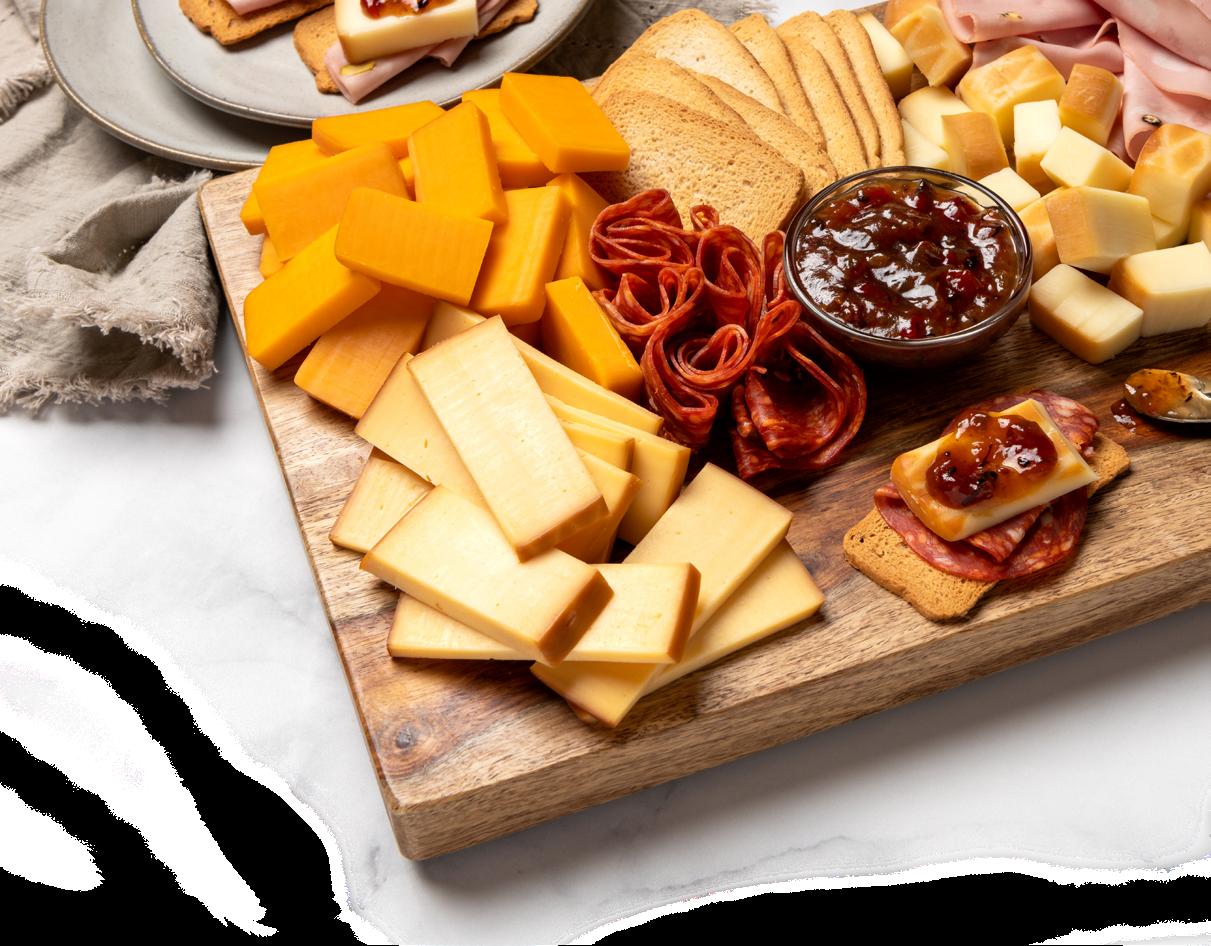
“It’s on almost the same parallel as Burgundy, in France, which is famous for its pinot noirs and chardonnays. So it makes a lot of sense that the grape varietals of Burgundy would grow really well in Oregon — and they do.” Both regions get rain in the fall and frost in the spring, and winters come early in both places. Those are things that pinot noir and chardonnay grapes absolutely love.
If there is a particular wine that you like — say, a cabernet sauvignon from Napa Valley — while you’re in the wine section, google where the grape originates from, Ball says. “If you’re used to drinking big California cabernets, you’ll discover that the cabernet sauvignon grape came from the Bordeaux region of France. Maybe try a bottle of that — you’ll find a lot of similarities, but they won’t be identical.”
Every bottle of wine is a time capsule of the soil, sunlight, rainfall and temperature of a specific place at a specific moment in its history. It’s one reason why wine people talk so much about good vintages and bad vintages. (A vintage is the year the grapes were harvested.) Each variable affects the grape in some way, which affects the wine that’s made from it. The same place, at different times, can give vastly different results.
Now think about the soil of the Old World (European wines, primarily), versus the New World (which includes the Americas, Australia and South Africa). Winemakers have been tilling and irrigating the soil, growing grapes and making wine in Burgundy for nearly 2,000 years. As a significant endeavor, they’ve only been doing that in Oregon since the 1960s. That alone will guarantee that Oregon’s wines will have a unique taste. It’s like cooking with a seasoned skillet Grandma used her whole life



versus one you just got from the store. The same dish will come out different.
Wine isn’t special in this regard. The next time you travel to another country, buy a can of Coca-Cola. You will find it both tastes the same as a Coke back home, and also tastes weirdly different. It’s because Coke uses local ingredients — local water, local agriculture, local regulations. It’s the same reason that French bread from New Orleans tastes and feels different than anywhere else in the world — it’s our local water and humidity.
And you don’t even have to travel far to get two very different wine experiences from the same grape. For example, Napa Valley cabernet sauvignons are very popular. But some Rouses shoppers prefer the same wine from Paso Robles. The same variety of grape, the same state. Those 250 miles make a big difference, though. Paso Robles has hotter summers, cooler winters and less rain. This gives its cabernets a bolder blackberry and dark cherry character, with higher alcohol levels and softer tannins. Sometimes, when someone says they don’t like a particular type of wine, what they really mean is they don’t like a type of wine from a certain place. See where else it is grown, and give it a try.

It makes sense that different places will yield wines that taste different. But why don’t two wines from the same region taste identical? Why does Veuve Clicquot taste so different from Moët & Chandon Imperial? They use the same grapes, both grown in the Champagne region of France.

The answer is the winemaker. After growers harvest their grapes and bring them to the winery, winemakers have to make a lot of decisions that will affect everything from the color of the wine to its flavor.
Humans have been making wine for 8,000 years. We’ve found a lot of ways to do it, each imparting some unique flair or effect. Aging a wine in an old oak barrel versus a new oak barrel will yield very different profiles, for example. And winemakers often endeavor to represent a “house style” — a new bottle of Veuve Clicquot today should taste the same as a new bottle did a hundred years ago — or express the soil and climate of the region (the “terrior”) and the natural characteristics of the grape.
It’s not just what the Earth and the winemaker do to a wine, however. There’s also what you do to it. For example: Do you drink it with food?
Because the French and Italians were making wines centuries before the New World was even discovered, their wines evolved with their cuisine, and vice versa. The one brings out the best of the other.
“Some of the wines we carry are great for drinking on their own,” Ball explains. The Rouses Recommends program can help shoppers figure out not only a great new wine to try, but also what they can expect when they get home. One recent recommendation, she says, is a wine called Custard, from the North Coast of California. “It is that kind of rich, oaky chardonnay with the sorts of butter notes that people might expect when they hear a name like ‘Custard.’ It’s a creamy, decadent type of chardonnay.” Another wine recommended from the same region is a cabernet called Fly by. “You’ll get the best of them even without pairing them with food.”
Food will elevate Old World wines, however. “If you are going to get something from Italy, or if you are going to get a Bordeaux, you would absolutely pair it with food, and the food would bring out the flavors of the wine,” she says.
By branching out, a would-be wine enthusiast can develop their palate faster than they might expect.
“We carry a really popular wine called Garúa. It’s just the perfect New Zealand sauvignon blanc — zippy and tropical and very crisp, kind of grassy, with a grapefruit thing going on in it. It’s a lot of fun.” So if you’re into drinking that, what else do you try? A quick search of the grape’s origin will reveal it originated in the Loire Valley of France. “You’re going to find that they taste very different, but they have enough in common that you’ll still really enjoy both.
And that really gives you a jumping off point for other grapes that grow in the Loire.”
Ultimately, it’s about being a little curious and a little adventurous, says Ball. “Your palate will get more and more intelligent as you go.”
ARROW-CIRCLE-RIGHT Charcuterie (pronounced shar-KOOD-eree) is similar to a classic Italian antipasto; it beautifully combines a variety of meats, cheeses and accompaniments. When building your charcuterie board, the key is balance — select both cooked and dry-cured meats and pair them with an array of cheeses. Don’t feel restricted to French or Italian varieties; cheeses from all over the world, including local American artisanal cheeses, can be excellent additions.
When planning your board, aim to include a range of textures and flavors in the cheeses you offer. Soft, spreadable cheeses like Brie or a creamy goat cheese contrast beautifully with semisoft options such as Fontina or Gruyère, and firm cheeses like Manchego or Comté. For extra variety, add a hard, chunk-able cheese like an aged Gouda or Parmigiano-Reggiano to bring a bold, salty punch to the board.
When it comes to quantities, the more varieties of cheese you include, the smaller the portions should be of each. A good rule of thumb is about half an ounce of each cheese per person, increasing to an ounce per person if you’re offering a limited selection of three to five cheeses. This ensures that each cheese has its moment without overwhelming the palate.
To enhance the cheese experience, complement the richness with briny, tangy accompaniments such as pickled vegetables, olives or caper berries. Sweet elements like chutney, honey, candied fruit or jam help balance the saltiness of the cheeses. A well-curated charcuterie board should also feature a mix of textures from the meats: Think pâté or rillettes for a soft contrast against firmer cured meats like prosciutto, salami or chorizo. A good Dijon mustard can provide an extra sharp kick that pairs perfectly with both meats and cheeses.
Finally, no charcuterie board is complete without a selection of vehicles for the cheese: Offer crusty bread, crisp crackers, crostini or even lavash for added texture and a satisfying crunch.
Rich flavor, bold aroma, smooth crema, perfect for espresso martinis.


